Lewin Benjamin (ed.) Genes IX
Подождите немного. Документ загружается.

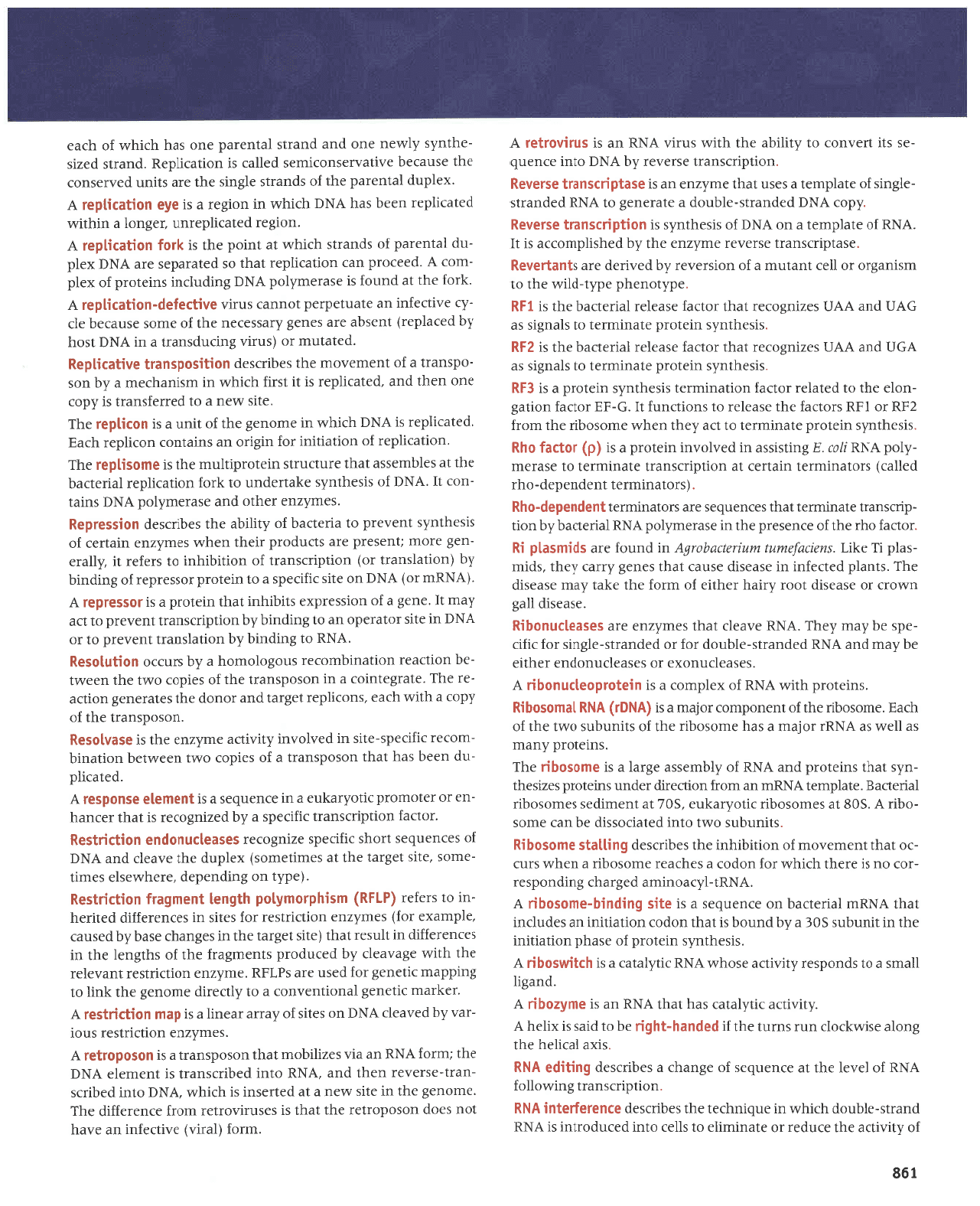
r98
Jo
^lr^rlJe aql e)npar ro alpuuqe
ot slleJ olur
peJnporlul
sl
VNU
puerls-elqnop qrrqM
ur
JnbruqJal aql sJqlr)sap
a)uaja#aluJ
vNu
'
uoIldIJJsuPrt
6ur,rrro11o;
VNU
Jo la^al
rql
le
eruanbes yo
a8ueqr
p
saqrr)sep
6up1pa
ypg
'SIXP
lPr{aq
aql
3uo1e asr.u>Irop unr surnl aql
Jr
papupq-f qEp aq ol
prps
sr
xrleq
V
'.{tr,rrlre
tp.dleter seq
lpql
VNU
ue sr
au/lzoqy
V
'pue31
Ileus
e ot spuodsar ,{rppre esoqu
VNU
rprlleler e sr qllll
soqF
V
'srsaqlu.ds
uralord
;o
aseqd uorlprlrur
Jqt ur
trunqns
S0€
p
[q
punoq
sI
teqt
uopoJ uopeltlul ue sapnlJur
leq1
vNuru
lerJelJeq
uo aluanbas
p
sr
alls 6u1pu1q-auosoqF
v
'VNU1-12{reou(ue
pa8reqr
Surpuodsar
-JOJ
Ou Sr aJaql
q)lq^t
roJ uopoJ e seqJeer eruosoqrr
p
ueqM srnJ
-)o
leqt luJura^orrr
Jo
uorlrqrqur eqt saqrrJsep
6up1e1s auosoq!U
'slrunqns
oMl olur
palelJossp
aq ueJ eruos
-oqlr
v
's08
1e
sauosoqrr rrlozi.re4na
's01.
lP
luarurpas
sauosoqlr
Ipuapeg
'a1e1dura1y51gru
up ruorJ uorpe4p repun suralord sezrsaql
-uLs
teqt
suratord
pup
vNU
yo
.dlqurasse
a8rel e sl
auosogF
aql
.SUIJlOICT
AUPIU
sp
IIaM
se
VNUr
roleru e seq auosoqrr aql
Jo
slrunqns o,trl eq1
]o
qref
'eruosoqg
rql
Io
tueuodruor
roleru e sr (ypgr)
VNU
leutosoq]U
'suratord
qtlu
VNU;o
xalduot
p
sr
uraloldoellnuoqF
V
'sasealJnuoxe
ro sesPalJnuopue raqlra
aq r{eur
pue
VNU
pepuerts-elqnop
ro} ro
pepuprts-alEurs ro; rr;I)
-ads
aq ,{.eur ,{.aq1
'VNU
a^eelJ
leql
saru.{zue are
sasealf,nuoqrg
'aseesrp
IIe6
U,t.roJJ Jo aseJsrp
loor
.{rreq rJqlra
}o
uroJ
aql e>1e1 ,{.eru aseesrp
aq1
'srueld
peDaJur
ur aspesrp esne)
leqt
saua8
[rrer ,{aqt
'spnu
-se1d
11 a4t1
'suanalawu
wrurapoqot0y ul
punol
are
spluseld
lU
'rotrpJ
oqr aql
Jo
eJueserd aqt ur aseraru.{.1od
ylqg
puaneq.dq
uoq
-dursuert
aleulural
leql
saruanbas alp srolpu[urat
]uapuedep-ot{U
'
(srolPuluuJl
tuJpurdrp-oqr
paler)
sroleurrural uleual
le
uorldrrJsuerl eleuruuel ol espraru
-,{1od
ygg
ttot'g Surtsrsse ur
pallolur
uralord e sr (d)
lope} oqu
'srsaqtuLs
uralord elpururral ot
tre
{aqt uaqM eruosoqlJ eql
uorJ
z{u
ro
IJU
sroDeJ
eql esealrr
o1 suorlf,unJ
1I'c-JE
rolre; uorle3
-uole
aqt
ol
palpler
rol)eJ uorleururat srsaqluz(s uralord e sl
€lU
'srsaqluLs
uralord aleururral o1 sleu8rs
se
Vgn
pue
yy3
sazruSo)ar
leql
rolJpJ
espelar
lerratJpq
aql sl
ZIU
'srsaqlur{s
uralord elpurrrrJel o1 sleu8rs se
gvn
pup
yyn
sazruSo)eJ
1eql
rot)e; asealer
lerJJt)eq
aqt
sr
trlU
'adLrouaqd
ad,{1-plm
aqt or
ursrue8ro Jo
IIeJ
luelnu
e
Jo
uorsrener
dq parruap
erp sluppalag
'aseldrnsuerl
esraler aruLzua aqt ,{q
paqsrtdruorre
sg
t1
'VNU
Jo
atelduret
p
uo
VNC;o
srsaqtu,{s sl
uogdFlsupJl eslelag
',{dor
VN(
pepuprts-elqnop
p
etpraua8 o1
y51g
papuerls
-alEurs;o
aleldruat
p
sesn
leql
aruzlzua up sr
aseldF)suell
esrena1
uorldrrlsuerl asrelar
{q
VnO
olur
eruanb
-as
slr
lJJAuor
o1 Llrlqe aql
qlr^\
snrr^
vNu
uP sr
snlnoJlal
Y
'ruJoJ
(lerl^) aAIpeJuI
uP a^eq
lou
saop
uosodorlar
eqt
tpql
sI sJsnrllorlar
ruoJJ JJuaraJJIp
aql
'aruouaE
eql
ul Jtls
Mau
p
tp
pauesul
sI
qJIqM
'VNq1
o1q
peqlrf,s
-uerl-asra^eJ
uaql
puP
'YNU
olul
peqlJJsuerl sl
lueuale
YNCI
Jqt
luro;
VNU
ue
prl
saz11rqotu
leql
uosodsueJl
e sr
uosodorlat
V
'saruAzua
uollJIJlseJ
snol
-re.r,{q
panealr
VNC
uo
salls
Jo.{erre
reau11
e sr
dPU UoIpYlsAJ
V
're>lrpru
rrtaua8
IeuoltualuoJ
e ol ,{prarrp
aruouaS
aql >Iu{ 01
Surdderu
rrlaua8
ro1
pesn are sdTdU
'aurr{zua
uollJlrlseJ
luPlaler
eqt
qtlM aEe.l,eap
.{q
parnpord sluaurEer;
aqr;o sqfual
eql ul
seruareJJrp
ur
llnsar teqt
(atls
la8ret
aql
u1 saEueqr
aseq,{q
pasner
'aldruexa
ro;)
saru.dzua
uollJlrtsar
roJ srtls
uI saJurreJJlp
perlJeq
-ur
ol sreJar
(aUU) uslrldroruflod
qt6ua1
luou6PlJ
uolpplsau
'(addr
uo Supuadap
'eJequasla
sarull
-eruos
'atrs
taEret
aq1
te
seullauros)
xaldnp
eql aleelJ
pue
VNC
;o
satuanbas
lroqs
rr;oads
aztu8orar
saseelJnuopua
uolllFlsog
'ro1re1
uorldlrJsuerl
rr;nads
e ,{.q
pazuEoJar sI
1eql
JaJuPq
-ua
Jo reloruord
r11o,{re1na
e u1 aruanbas
P sI
luauela
asuodsol
V
'pa1e;11d
-np
uaeq
seq
lPql
uOSOdSuerl
e
;O
setdor o^{l
uaaMleq
uolleulq
-ruoJJr
rr;oads-atts
uI
peAIoAuI dtplpe
aru[zua
aql sT
oseAlosag
'uosoosuerl
eql
Jo
Ldor
e
qtlm
qree
'suorlldar
la8rel
puP rouop
eql salerauaE
uolDe
-ar
eqJ
'ater8alutor
e u1 uosodsuerl
aql;o
satdor
oMl eql ueoMl
-eq
uorl)par
uorlpurqruo)ar
sno8oloruoq
e,{q sJnJ)o
uognlosog
'vNU
01 Surpurq
zlq uorlelsuert
luanard
ol ro
VN61
uI alts
rolerado
ue o1 Eurpurq
dq
uorldtnsuerl
lua,tard
o1
1re
^etu
U
'aua8
e;o
uorssardxa
sllqqul
leql
ulalord
e sr
lossaldal
V
'(VNUru
ro)
y51q
uo atgs
rgpads
e o1 utalord
rossardar
;o
Sutputq
.{.q
(uouelsuert
ro) uortdrr)suen
Jo
uolllqlqq
ot sraJJr
r1
',{11era
-ua8
aroru
lluasard
are sDnpord
Jleql
ueqM
saur,{zua
uleual
Jo
srsaqlu.ds
lua,rard
ol
plraDeq
Jo
.dtrnqe aql
seqlJJsap
uolssaldag
'saru,4zua
JJqlo
puP
aserar.u,{1od
VNO
sulel
-uor
u
'vNC
]o
slsaqtu,{s
e{ellJpun
or
IroJ
uolte:11dar
IeIrJl)Pq
aql
le
salqtuassp
lpql
arntrnrls
uralordlllnru
aql sI
otuoslldel
aq1
'uolter11dar
Jo
uolteltlul
ro;
ur8tro uP
suleluo)
uorlldar
qreg
'paterlldar
sl
VN61
qJIqM ur atuoua8
aql
Jo
llun
e s1
uorlldel
eq;
'elJS
Mau P ol
PaJJJJsuerl
st [do:
auo
ueql
pue
'parerldeJ
sI
1l ISJIJ
qJlq/v\ uI ursluPq)aur
e zlq uos
-odsuerl
e
Jo
lueurJlou
aqt
seqrrf,sep
uolllsodsuPJl
elpellldag
'petelnru
ro
(snrr,r
Sutrnpsue.rl
e
uI
YNC
lsoq
.{q
pareldar)
luasqP
are
saua8
Aressalau
aql
Jo
eluos
esneJeq
alf,
-,{.r
anrpa;ur
ue alenladrad
touuel
snrll
olglalsp-uo$erlldal
V
'>lroJ
aqt
lp
punoJ
sr
aseraru[1od
VNO
Surpnpur
surelord
1o
xald
-ruoJ
V
'paarord
uer
uoperqdar
leql
os
paleredas are
y51q
xald
-np
leluared
Jo
spuerls
qrlqM
te turod
aql sl
lro1
uopellldat
V
'uor8ar
palelldarun ?a8uo1
e uIqlIM
parerlldar
ueeq
seq
vNo
qrlqM ur uot8ar
P sI
e/[a uogP]lldal
V
'xaldnp
leluared
eqt
Jo
spue[s
alEurs
aql are
sllun
pelrasuoJ
eql esnpraq
alllelJasuoJlues
peller st uorlerlldag
'puPJls
pazls
-aqlu,{s
L1,uau
auo
pue
puerts
leluared
euo
seq
q)IqM
Jo
qJPa
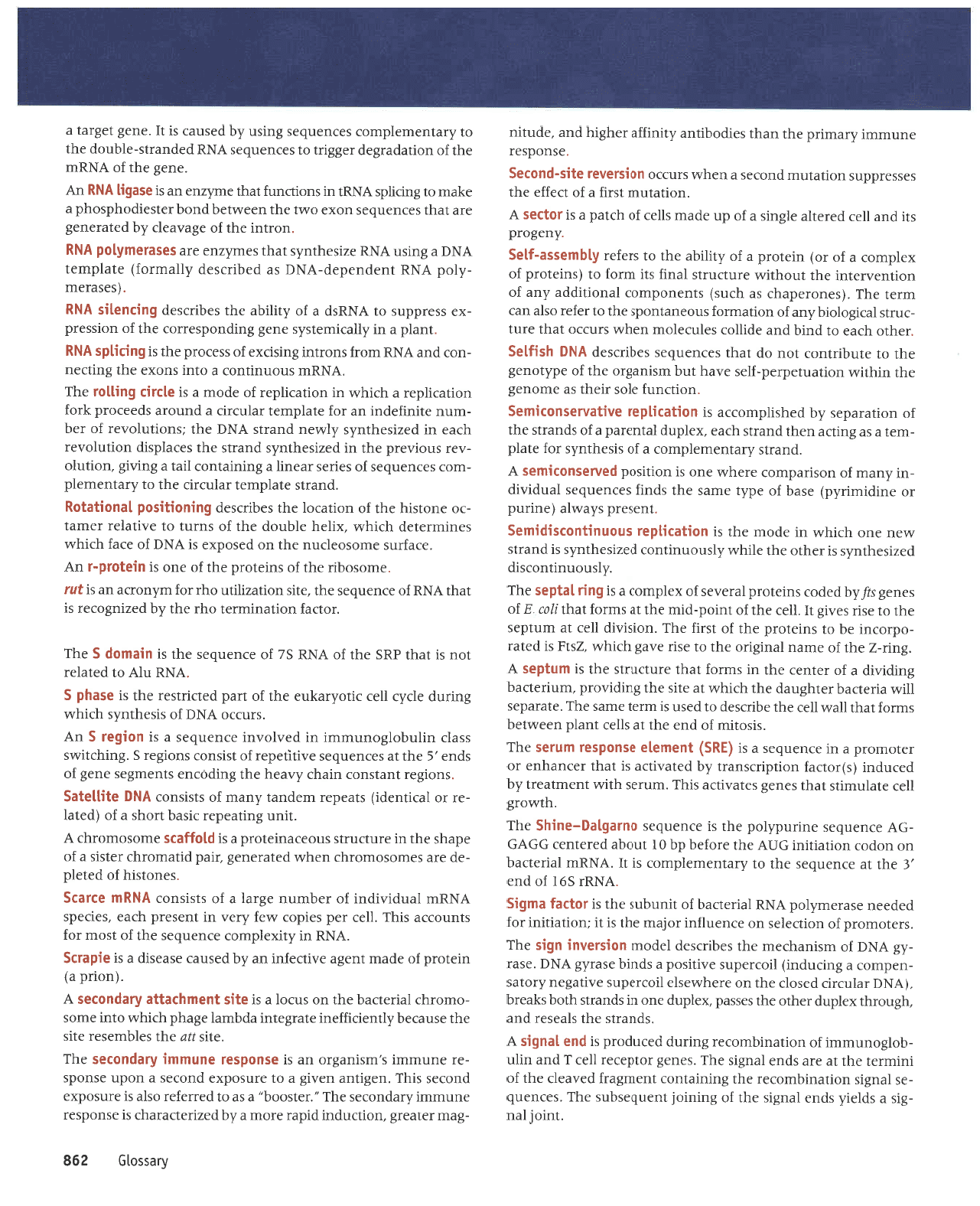
'IUIOt
Ieu
-Ers
e splarL spua
leu8rs
eqt
Jo
SururoI
tuanbasqns
aq;
'satuanb
-as
leu8ts
uollpurqurof,er
aql
8urureluor
luaru8eJJ
peneap
aqt
Jo
rurrurel
Jql
le
aJp
spua
1eu8rs
aq1
'saua8
rolda)er
IIaJ
J
pup
urln
-qolEounuur
Jo
uorteurqurorar
Suunp parnpord
sr pua
lpu6ls
V
'spuerls
eql
slPJsar
pue
'q8norql
xaldnp
raqto
aql sassed'xaldnp
euo ur
spupJls
qloq qparq
'(VNC
rpln)rrr pesolJ
eqt uo
ereqMasle
lotradns
anlte8au,{roles
-uadruor
e
Euonpur)
lorradns
arr1l1sod
p
spurq aser.r{.8
VNC
.aseJ
-[3
VNC
]o
usrupqJarrr
eql
saqrr)sap
Iapou
uolsanu!
u61s
aq1
'sraloruord;o
uorl)elas
uo
a)uanlJur roleu
aql sr
1r
luorlerlrur
JoJ
pepeeu
aseraru.dlod
VNU
Ierratrpq
Jo
tpnqns
aqt
s1
ropel eur615
'vNur
s9I
Io
pua
,€
aql
1e
aruanbas
aql
o1 ,{.retuaualdruor
sl
rI
'VNUur
lerratJeq
uo uopor
uorlertrur
gnv
eql
eroJaq dq
61
fnoqe
parelual
CSVC
-9y
aruanbas
aurrndLlod
aqr sr
aruanbes
oulp6le0-eulqs
JqJ
'qUrao-r8
IIaJ
elelnulls
leql
saua8
selP^rlJe
srql
'unres
qlwr
luaulea-r1
,{.q
peJnpur (s)rope;
uortdulsuen
,{.q
patea.rtre
sr
tpql
reJuequa
ro
raloruord
e ur aruanbes
e sr
(3g5)
luauale
asuodsar unres
aqJ
'srsolrlu
Jo
pue
Jql
le
slleJ
tueld
uaa,ulaq
srurol
leql
IIeM IIe)
aqt eqrrJsap
ot
pesn
sr urret erups
JqI
.aleredas
IIrM
prraDpq
Jarq8nep
eqt qJIqM
le
ells
eql Surpr,rord
,urnrreDeq
Surpltp
e
Jo
rJlua)
eql ur sruroJ
leq1
arnt)nJts
aql sr
unldes
V
'8urt-7
aqt
Jo
etueu
leurSrro
aqt ol
asrr a,re8 qrrq,u
,Zsld
sr
palpr
-odrorut
aq ol
suletoJd
aqf yo
lsrrJ
aqJ
'uorsr4rp
IIar
te
runtdas
aq1 ot asrr
saarS
t1
'llal
aqt
;o
lurod-prur
Jql
tp
sturoJ
:l'rtrt
lln
g
lo
sauaE
s/l.q
pepo)
suratord
1era,r.as
yo
xeldruor
e s1-6up
leldes
eq1,
'AISnonurluo)srp
pazrseqlu.rls
sr reqlo
aqr
alq,ra Llsnonurluo)
pazrsaqlu.r{s
sr
puerls
,lreu
euo
qrlqu
ur apou
aql
sr
uorlefJlda.t
snonulluolslplues
'luasard
s,{e,tr1e
(aurrnd
ro aurprurrr.dd)
aseq;o
adLl erues
aql spur;
saJuanbas
lenprnrp
-ur,{.ueru
yo
uosrredruoJ
erJqM
auo sr
uorlrsod
paruasuo:tuas
V
'pueJls
,{.retuarualduroJ
p
Jo
srsaqtu,{s
ro; a1e1d
-Iuel
P se Surpe
uaql puprts
qrea
'xaldnp
leluared
p
Jo
spuerls
Jql
;o
uorleredas
Lq
peqsllduoJ)e
sr
uollpllldel
alllpruasuotJtuas
'uorl)unJ
JIos Jreql se
aruoua8
aql ulqll1ll uotlentedrad-Jlrs
a^eq
1nq
rusrue8ro aqt;o
ad,fuouaE
aql ot
elnqrrluoJ
tou
op
reql
saluanbas
sJqrJJsap
VNg
rls$las
'raq10
qJee
01
pulq
pue
aprllo) selnJalour
ueq^{
srnrro
leql
ernl
-rnr1s
lerrEolorq,{ue;o
uorlpuroJ
snoaueluods
aql 01 JaJaJ oslp
ueJ
urel ar{J
'(sauoradeqr
se qrns)
stuauodruor
Ipuortrppp,{ue;o
uollua^relul
aql
lnoquM
ernDnrts
leurJ
slr
turoJ o1
(suratord
Jo
xalduror
e yo ro)
uleloJd
e
;o
,{1rtqe
aqt ot sraJJr
/ilquasse-l1a5
'zluaSord
sll
pue
IIa)
peralle
a13urs e
;o
dn aperu
sllr)
Jo
qrted
e sl
.topes
V
'uorlPtnru
lsrrJ
e
Jo
DeJJe
aql
sassarddns
uorlplnu
puoJes
p
ueqm srn))o
uoJgeAal elts-puoJeS
'esuooser
aunururr.,{.rerurrd
aqt
ueqt serpoqrlup;h1u1ge
raq8rq pue
,rpntru
^ressolg
zgg
-3eru
ratearE
'uop)npu
prder
aroru e Lq
pazrralreJeqJ
sr
esuodsJr
aunrurur,{repuof,Js
eq1.,'Jalsooq,, e se ol
paJreJJJ
osle sr arnsodxa
puoJes
srql
'ua8rlue
uarrrS e
ol eJnsodxe
puoJas
e uodn
esuods
-ar
aunurur s,rusrueSro up
sr
asuodser eunuu! /fuepuotas
aql
'a7rs
ila
Jql
selquesal Jlrs
aqt esneraq z(pualJrJJaur aler8alur epqrupl
a8eqd
qrrq,vr
olul euros
-ourorq)
IprratJeq
eql uo snJol e sr
alls
lueuqtpDp
/Uepuolas
v
'(uorrd
e)
uralord
Jo
epeu
tuaSe
azrrDalur ue dq
pasner
eseesrp
e sr
eldelr5
'VNU
ul
dtlxalduror
aluanbas
eq1
Jo
tsolu
roJ
slunoJJp
sIqJ
'llal
Jed sardoJ azra; ,{rarr
ur
luasard
qJee
'ser)ads
VNUIU
lpnpr^rpur
Jo
Jequnu e8rel
p
Io
slsrsuoJ
VNUUt
alJels
-rp
ere saurosoruoJqJ ueqM
palerauaE
,,"0
p,rltXllljtl#ff:tji
adeqs aqt ur erntrnrts
snoJJeulalord e sr plogers
eurosoruorqJ
V
'llun
Surlpader )rspq
Uoqs
e yo
(pa1e1
-ar
ro
leJrtuapr)
sleadar rrrapuet ,{ueur
;o
slsrsuof,
VNq
allllales
'suor8ar
luelsuor
ureql .{,reaq
eql SulpeJua
sluaru8as
auaE
;o
spua
,E
eqt
tp
saruenbas
anrllladar
Jo
lsrsuo)
suor8ar
5
'Eurqllraa.s
ssplJ urlnqolEounrurur
ur
pellolur
aruanbas
e sr
uot6ar
5
uy
'srnJ)o
vNC
Jo
srsaqtuz(s qrrqrrrr
Eutrnp apLr
1ar
rrlo^re>lne
aqt
;o
ged
palrrrtsal
aqt sr
aseqd
S
'vNu
nlv
01
palelar
lou
sr
leql
dus
eql
Jo
vNu 51
;o
aruanbrs
rql sl
uJeuop
s
eqJ
'roDeJ
uorleurruJal or{J
aqt dq
pazruEolar
sr
leql
vNU
Jo
eJuenbas aql
'alls
uorlezlllln oqr ro;
ru.duoJJe ue
sr
lnf
'eurosoqrr
eql
Jo
surelord aqt yo
Juo sl
ulolotd-r
uy
'ereJrns
JruosoalJnu rql uo pJsodxa
sl
yN61
Jo
eJeJ
qJIqM
saurruretep qJIqM
'xrlaq
alqnop
agl
Jo
surnl
o1 e^Ilelar rerupl
-Jo
Juolsrq aql
Io
uorle)ol
eql seqrJJsap
6uluolllsod
';euogelox
'puerls
aleldual rplnf,rrJ
aql ol ,{.re1uarua1d
-ruoJ
se)uJnbas;o
sarras JpJurl
p
Eurureluor
lel
e EuIAF
'uor]nlo
-,Lal
snor,rard aq1 ur pJzrsaqluls pupJls
aqt
sareldsrp
uorlnlolar
qJea
ur
pazrsaqluls
zllrnau puerts
vN61
eql
lsuorlnlolal
Jo
req
-runu
euulJepur
up ro; aleldrual
relnJrrJ
p
punoJe
spaarord >Fo;
uo11er11dar e
qJrqm
ur uorlerqdar
Jo
epou e sr
allrll 6u51or
aq;
'VNUru
snonurluoJ e olur
suoxa aql
8urlrau
-uoJ
pue
VNU
tuorl
suorlur Sursoxa yo ssarord
aqt
sr
Eupgds
ypg
'1ue1d
e ur .{11ernua1sLs
auaE
EurpuodsarroJ
oql
Jo
uorssard
-xa
ssarddns or
VNUSp
e
;o
z{11gqe rql
saqrJJsap
6upual1s
y1r1p
'(seseraIu
-,(1od
yyg
luapuadap-yNe
se
paqrrJSep
,{.11eurroy)
aleydurat
vN11
e Eursn
yltrg
azrsaqtu,{.s
leql
saru[zua
ere
saspteuflod
VNU
'uortur
aqt;o a8e,reap
,{q
paleraua8
are
tpqt
sacuanbas
uoxe o,lrt aqt
uaaMleq
puoq
relsalpoqdsoqd
e
aleru or Surcqds
y5191
ur suou)unJ
leql
au.dzua
ue sr
ase611
VNU
uV
'aua8
aql
Jo
VNUIU
eqt
Jo
uoupper8ap ra83rn
ot saruanbas
VNU
papuerts-alqnop
eql
ot,{reluaualdruor
saruanbas Sursn z(q pasner
s1
t1
'auaE
t;,?rcle
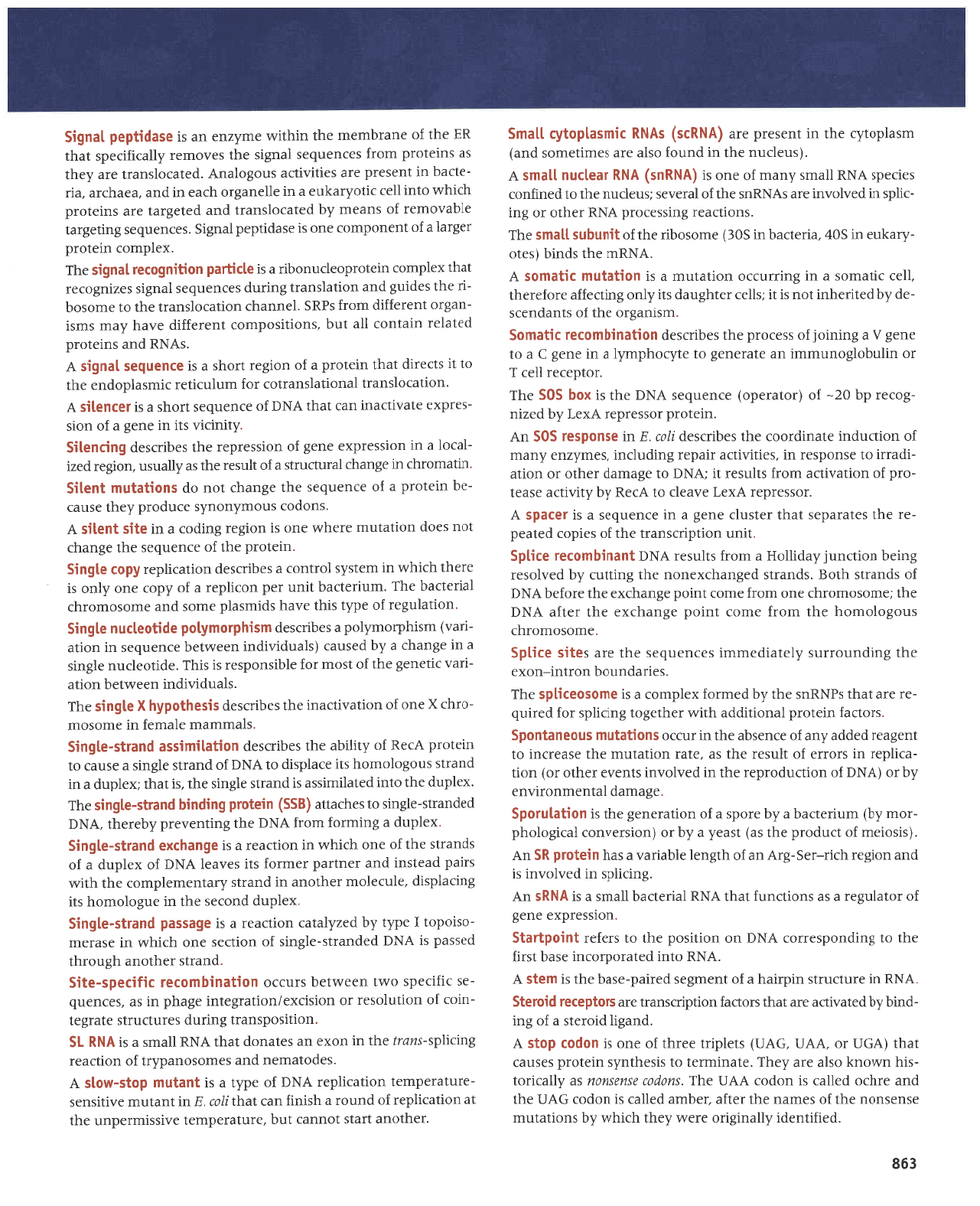
€98
'parJrluapr
.{leut3rro
araa,r {aql
qJIqM
[q suortetnru
asuasuou aql
Jo
seluPu aqt relJe ?Jqrue
pelle)
sr uopoJ
9vo
aq1
pup
eJqJo
palle)
sr uopol
1trvn
etfl'suopu asuasuou se
,{11errrol
-srq
uMou{ osle eJe ,{.aq1
'aleunural
ol srsaqlu,{s uralord sasne)
teqt
(VOn
ro
'Vvn
'gvn)
steldul aan{t
}o
auo sl
uopol dols
V
'pue8u
plorats
e;o
8ut
-purq
zlq patelrpe
erp
teql
sroDeJ uortdrrJsuert arp
stolde)et
plotals
'vNu
uI eJntJnrls
urdrreq e;o
luaruEes
pafied-aseq
aql sr
uels
v
'yNU
otq
palerodrorur
asPq
lsrl;
aqt ot Sulpuodsar.ror
VNC
uo uoltlsod eqt ot sraler
lulodpels
'uorssardxa
auaE
;o
roleln8ar e se suorpunJ
lpql
VNU
lprreDeq Ilerus
p
sr
VNUs
uV
'duIJIIoS
UI
peAIoAuI
sI
pue
uor8ar
qrrr-rag-3ry
ue
1o
qfual
alqeue^ e seq
uralord
g5 uy
'(srsoraru
;o
pnpord
aqr se)
lseazl
e .{.q ro
(uorsra.ruor
1el8o1oqd
-roru
r(q) urnrrJppq
e.{.q arods e
Jo
uortpreua8 aql s1
uo$plntods
'ebeuep
lElueluuorl^ue
.{.q ro
(VNC
}o
uorlJnpordar aql ur
pallolur
sluala raqlo.ro)
uorl
-erqdar
ul srorJe
Jo
llnseJ
ar{l sp
'aler
uorlplnru aql asperJul ol
tua8ear
pappe ,(ue
Io
eJuesqp aql ur JnJJo
suonelnu snoeueluods
'srolJeJ
uralord
Ieuortrppp
qtplzr
raqtaEol
3unlds ro;
palnb
-er
eJe
lpq]
sdNuus aqt r{q
paruroJ
xalduror e sr
auosoatllds
aq1
'serJepunoq
uorlur-uoxe
eql Sulpunorrns
.{lalerparurur sJ)uenbas aql are salrs
allldS
'euIosoIuoJqJ
snoSolouoq aqt urorJ auor
turod
aSueqrxa
aql relJe
VN(
eql
lauosourorqr auo ruorl aruoJ
lurod
a8ueqrxe eqt eroJeq
vNO
Jo
spuprls
qlog
'spupJts
paEueq)xJuou eqt 3ur11nr zlq
pa.l,losar
Suraq uorlrunt,{.ep11o11
e urorJ stlnsar
VNC
lueulquolet
elJldS
'1run
uorldrnsuprl eql;o
sardor
palead
-aJ
aql saleredas
leql
Jalsnl) aua8 e ur aluenbas
p
sI
relgds
V
'rossardar
VxJT
JApalJ ol
VIJU
,{q ,{trnrt:e aseal
-ord;o
uortelrpe ruorJ sllnser
1l
iVNC
ol aSeurep
reqlo ro uolte
-rpeJrr
ol asuodsar
ur
'serlrlrl)p
rredar Surpnput
'saru,{zua
.{ueru
Jo
uorDnpur
alpurpJooJ aql seqrJlsap
qu'gur
esuodsal
SOS
uV
'uralord
rossardar
yxal
zlq
paztu
-3orar
dq
OZ-
Io
(rorerado)
aruanbas
VNq1
aqt sl
xoq
S0S
eql
'roloe)ar
IIaJ
I
ro
urlnqofounrurur ue ateraua8 ot alboqdurz(1
e ut auaS
3
e ol
aua8
n
e Sururo[;o
ssarord aqt saqrrJsap
uogeulquo]et
lpeuos
'ursruEtsro
aql
Jo
sluepueJs
-ap.dq
paluaqur
lou
sl
tl
ls11ar
ralq8nep str,{.1uo 3u1na;;e
eroleraql
'lleJ
Jrleuros
e ur Surunlro uorlelnru e sr
uollelnu t$ptuos
V
'VNUru
aqr spurq
(sero
-.,i.re>1na
ur
Sgt
'prrat)Eq
ul
S0€
)
euosoqlr Jql
Jo
llunqns
lleus
aqJ
'suorDper
Surssarord
VNU
raqlo
to 8ut
-r11ds
ur
pa,rlolrrr are sVNUus aql
Jo lpre^es
lsnepnu aq1 01
peulJuor
saoads
VNU
llprus
,,{.ueru;o auo sr
(ypgus)
VHU
teellnu
llplus
V
'(snapnu
eql
q
puno;
oslp
erp sarutlaruos
pue)
urseldo{.r
rqt ur
tuesard
are
(ypgrs)
sVHU )lluspldoill
lleus
'reqloue
uPls
louueJ
lnq
'arnleradlual
eAISSIuradun
aqt
1e
uorlerrldar
Jo
punor e
qsIuIJ uw
Teql!p)
A
uI
luelnru
ellllsuas
-arnleradrual
uorleJllder
yNC
io
adz(1 e sr
luqnu
dop-mols
V
'sapoteurau
pue seurosoued,{.rl
;o
uollrear
Eurtrlds-sua4
aqt
ul uoxJ
ue selpuop
leql
VNU
IIPUS
e sl
VNU 15
'uorlrsodsueJl
Surrnp
sarnJJnrls aler8al
-uroJ
Jo
uollnlosar
Jo uolslJxa/uorler8alul
a8eqd ur
se
'saruanb
-as
rr;1rads
o,lrl ueeMleq
srnr)o
uolleu!quolat
lllpads-ells
'puPrls
reqlouP
qBno;qt
pessed sI
VN61
papuerls-a13uls
Jo
uoll)as
auo
qrlqu
uI esPrrru
-osrodot
I
adzh
,{q
pazzlpter
uopf,per
e s1
a6essed
pue.lls-ol6uls
'xeldnp
puof,es aql uI antsolouoq
su
Suoeldsrp
'elnJelotu
raqlouP
uI
puerts ,{reluarualduro)
aql
qllm
srred
pealsut
pue raulred JeruroJ
sll
seleel
YNC
Jo
xaldnp e
;o
spueJls
aql
Jo
auo
qJIqM uI uolt)eer
e sr
abueqlxa
puPlls-el6u15
'xaldnp
e Sunuroy
uorJ
YN(
aql Eurluarrard
[qaraqr
'y51q
papuerls-apurs
ol sarpelte (955)
ulalotd
6u1pu1q
puefls-el6uJs
eqJ
'xeldnp
Jql
otq
pelelllulsse sI
puPrls alEurs
aql
'q
leql
lxaldnp e ut
pueJls snoEoloruoq
s1r areldsrp
ol
YNC
Jo
puerls alEurs
e asneJ ol
uratord
V)eU
Jo
Ilrtrqp
eql seqlrrsep
uoJlPlllulsse
puerp-elbulS
'slPuruPu
aleuleJ
uI aruosour
-orqr
X
euo
Jo
uorlelltreul
aqt srqlrJsep
slsaqlod/tq
X
al6uls
aqJ
'slenpl^Ipul
ueaMlaq
uolle
-rrpl
JIleuaS
eql
Jo
lsotu
ro; alqrsuodser
sI sIqJ
'aprloalrnu
alEuts
e
ur a8ueqr
e
,lq
pasner
(slenprzrrpur
uaauleq
aruenbas
uI uolle
-ue.r,)
rusrqd-rour.{.1od
e saqrrrsep
us!qd.rotu/tlod
eppoalrnu
a16u15
'uorlelnEar
yo
ed,{.1
slqt
r^eq sprurseld
Juros
pue aurosourorqJ
Ierrel)eq
aqJ
'runlrelreq
l1un
rad uolqdar
e
;o
,{dor
auo ,{1uo sr
araql
q)rq1!\ ur rualsz(s
IoJluoJ
P seqlrJsep
uollP)Idar
/(dor
a16u15
'uralord
aql
Jo
eJuenbas
aqt a8ueqr
lou
saop
uoltPlnlu
areqM
auo
sr uorSar
Sutpor
e ul
ells
lualF
v
'suopoJ
snoruluou,{s
acnpord
zlaql asner
-aq
uretord
e;o aruanbas
aql aEueq;lou
op
suollPlnu
lualls
'urteurorqr
uI a8ueql
prnpruls
e
Jo
llnsar
aqt
se zllensn
'uo6ar
pezt
-leJol
e ur
uogssardxa
auaS;o
uotssardar
aql sJqIrJSap
6upue115
't(lru1or.t
st1
u1 aueE
e
]o
uors
-sardxa
alelrtrpul
upJ
tpqt
yNO
Jo
aruanbas
lroqs
e sI
laluelF
V
'uoltprolsuprl
leuollelsuerloJ
roJ
lunlnf,Ilar
lrruseldopua
aql
ot
1r
strarrp
teqt
ularord
e
;o
uot8ar
uoqs
P
q
eluenbes
1eu61s
v
'sVNU
puP
sutalord
palelar ulptuoJ
IIe
rnq
'suorlrsodruol
tuaJeJJIp
aaeq
,{eru surst
-ue8ro
tueralJlp
luorJ
sdUS
'leuueq)
uolleJolsuerl
eql ol
auosoq
-1r
aqt sapln8
pue uollelsuerl
Surrnp
saruanbas
leu8ts
sazruEorar
reql
xaldruor
uratordoapnuoqlr
e sl
alJlyed
uoJllubolel
lPu6ls
aqJ
'xaldruor
urelord
ra8rel
e;o
luauodruor
auo st
aseprldad
pu8r5
'seruanbes
Eurla8rel
alqplourar
Jo
sueau
.{.q
patelolsuPrl
pue
pala8rPl are sulalord
q)lqM olul
IIer
)llo^rP>lne
e
ur a11aue3ro
q)Pe
uI
puP
'Eeeq)rP
',PIr
-eDpq
ur
luasard
aJe saIIIAIIJP
snoEoleuy
'pale)olsueJl
are
Laql
sB
suralord
IuoJJ sJJuenbas
leuErs
aql
salorrral
,{1prr;oads
teqt
u[
rql
]o
euPrquau
rql
ulqll1!\
erulzua
ue
sI
asep$dad
1eu615
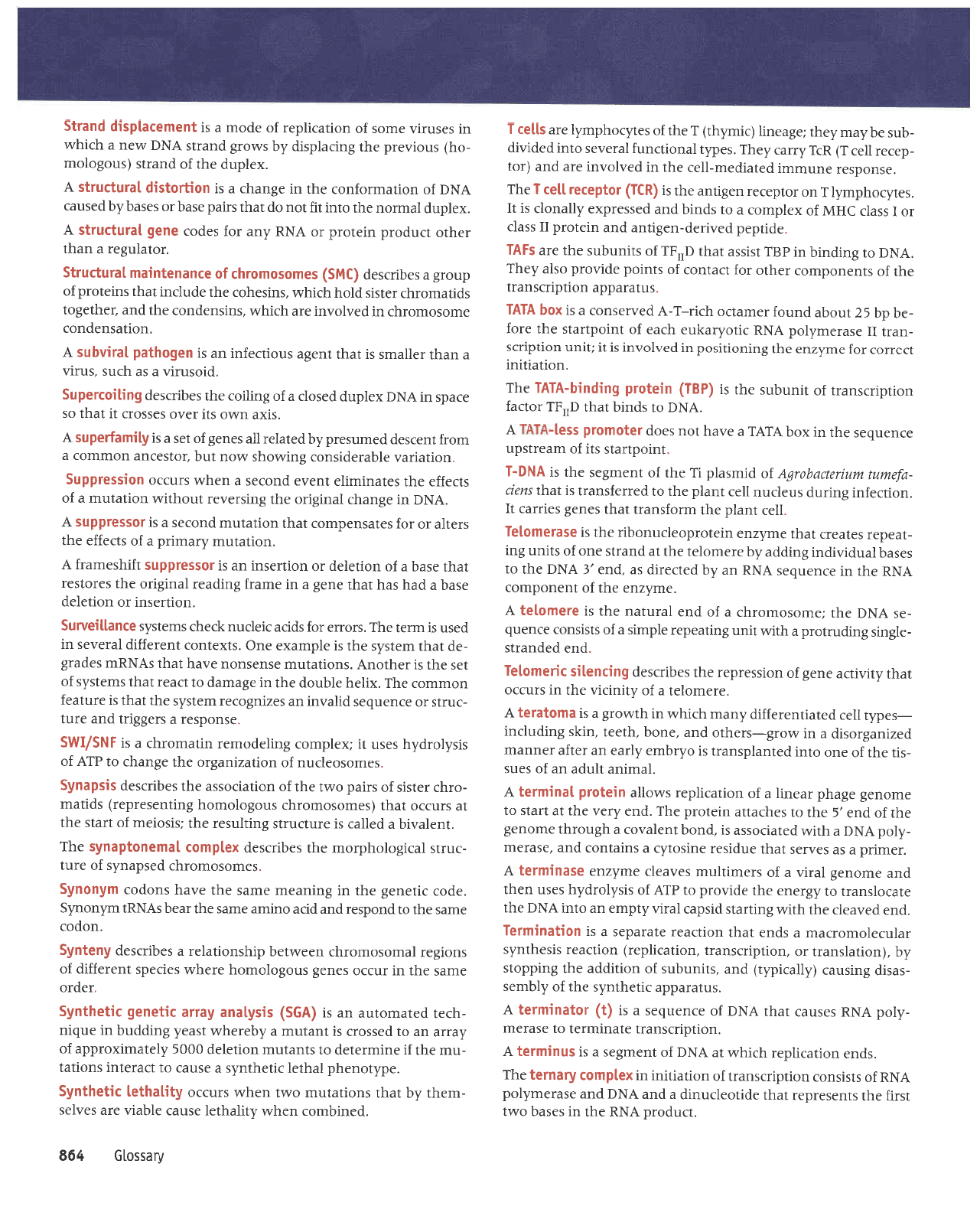
'lJnpord
vNu
eq1 ur sJseq
oMl
lsrlJ
aql stueserdel
leqt
Jplloalrnurp
e
pup
VNC
pup
Jselau^lod
VNU
Jo
slsrsuoJ
uorldrJJsupJt
Jo
uoupplul
ur
xelduol
fueu.ra1
aq1
'spue
uorle)r1dar qrrqlr
tp
VN_A
Jo
tuaur8as
e sr
snulutal
V
'uollorr)sueJl
aleururJel
ol aspreru
-.{1od
yNg
sesner
tpql
VNC
;o
aruanbas
p
sl
(l)
toleulutel
V
'snteredde
rltaqtur{s
aqr
;o
.,i.1quas
-sesrp
Sursner (.{1errd,{1)
pup
,suunqns
Jo
uorlrppe
aq1 Burddots
.,{.q'(uortelsuerl
ro'uolldlr)suert'uorterrldar)
uoll)par
srsaqlu.r{s
JelnJeloruoJJeur
p
spuJ
lpqt
uou)pJr
ateredas
e sr
uotlpulutlal
'pue
paleel)
aq1
qrl.tr
Surlrets prsder
1err,r,{tdrua
ue
olur
VN(
eql
elPJolsuPrl
ol LSraua
aql aprzrord
ot
dJV;o
srs,{1o:p,{.q
sasn
ueql
pue
aruoua8
Ierrl
e
Jo
sreurrllnu
selpalr
arul.zua
aseuluuol
V
'rarurrd
p
se selJes
lpql
enprsJJ
aursolu(r
e sureluoJ pup
,aserau
-,{.1od
yNlq
e
qtrM
petprJossp
sr
'puoq
luelplo)
e
q8norql
aruoua8
aqt
Jo
pua
/E
eqt
ot saqJppp
uralord
eql
.pue
,,ha,,r
aql
lp trpls
ol
aruoua8
a8eqd
reaurt
e
;o
uorterrlder
s,lrolle
uralold
leululal
V
'leluruP
tlnpe
uP
Jo
sans
-srl
eql
Jo
auo
olur palueldsuerl
sr
o,{.rqrua .,{1rea
up ralJp
Jauupru
pazrue8rosrp
e ur
,norE-sreqlo
pup
,Juoq ,qtJal
,ur4s
Burpnpur
-sad.rh
IIaJ
pelprluaragrp
.,{ueur q)lqM
ur
ql,u,or8
p
sr
stuolptal
V
'arauolel
e
Jo
AlrurJr^
eql
ur srnJJo
teql
^trlrlrp
auaS;o
uorssardar
aql seqrrJsap
6upualrs
lyeuolal
'pua
papuerls
-alEurs
Surpmlord
e
qllu
llun
Eupeadar
aldrurs
e
]o
slsrsuor
aruanb
-es
vNC
eql
leuosourorq)
e
Jo
pue
Iprnleu
eqr sr
aleuolal
v
'aru,{zua
aql
;o
luauodruor
VNU
aqt ur
aluanbas
VNU
up ,{q paparrp
sp
,pue
,€
VN(
eqt ol
seseq
Ipnprlrpur
Surppe
Lq rrJruolat
aql
tp
puprls
auo;o
slrun Bur
-teadar
selparr
leql
au^zue
ulalordoalJnuoqrr
aqt
sr
aselauolal
'1ar
tueld
Jql urroJsuert
teql
saua8
sarrrer
tI
'uorlJaJur
Surrnp
snelJnu
11ar
tueld
aql
ol
parJeJsuerl
sr
fetqf
suan
-alawnl
wnualtaqot|y;o
pnuseld
rI
eqt
Jo
luaru8as
eqt
sl
VNq-I
'luroduels
sU
Jo
ruearlsdn
aluanbas
aqt
ur xoq
VJyJ
e alpq
tou
seop
talouotd
ssel-
V
'VNC
or
spulq
lpql
qllgl
roDe;
uorldrnsue.n
Jo
llunqns
aqr
sr
(4g1)
ulalotd
6u1pu1q-y1y1
aq1
.UOIlPIIIUI
DarroJ
ro; aru.dzua
aql Suruorlrsod
ur
pa,r1o.,r.ur
sr
lr
llrun
uorldrns
-uerl
II
ase-raruLlod
vNU
Juo^re>lnJ
qJea
Jo
lurodtrBts
eql
aroJ
-aq
dq
EZ
tnoqe
punoJ
raruetJo qtlr-J-v
palrasuoJ
e sr
xoq
VIVI
'snleredde
uorldrrtsuerl
aq1
Jo
stueuoduor
raqlo
roJ
DetuoJ
Jo
slulod
apr,rord
os1e.,i.aqg
'VN(I
or
Eurpurq
ul
dgJ
lsrsse
leqt
(II{I
Jo
strunqns
aqt
Jre
slvl
'aprtdad
pa^rrap-ua3rlup
pup
ulrtoJd
II
ssplJ
ro
I
sselr
)HW
Jo
xaldruor
e ot spurq pue
passardxa
z(1euop
s1
tI
'sa{roqdru.{1
l
uo
roldarar
ua8rlue
aql s1
(g1)
rolda:er
llat I
aqJ
'asuodsar
eunurrur
paterpeu-lle)
aql
ul
pello^ur
are
pue (ro1
-darar
11ar
1)
gr1
,{rrer.{aq1
.sadz!
Ipuon)unJ
lereles
olur
paprlrp
-qns
aq Leru,{aqt
la8eaurl
(rnu,{qt)
J
Jq1
Jo
sail:oqdru,{1
are
sllel
I
rtessolg
t98
'paurquor
uaqu,{lleqtal
JSneJ alqprl
eJe sallas
-ruaqr
z(q
leqt
suortelnru
oMl uaqM
srnJJo
/i1geq1a1
)llaqlufs
'ad{louaqd
Ipqtel
Jrlaqtu,{s
e asner ot
tleJelul
suortel
-nru
eql
Jr
eururrJlep
01 sluetnru
uortelap
gggg
.{.laleurxordde yo
zlerre
ue ot
passorJ
sl
luetntu
e
^,{.qaraq.tr
lsee,{.
Surppnq
ur anbru
-q)at
petptuolnp
up sl
(VgS)
s1s/[leue /[eue
rgaua6 r11aq1u/ig
'rapJo
arups aqt
ur JnJ)o saua8
snoSolouroq
ereqm sapads
luareJJrp
Jo
suorEar
leuosouorqJ
uaaMteq
drqsuorlelar
p
saqrrJsep
/[ua1u/i5
'uopoJ
arups aqt
ot
puodser pup
pDe
ouurp arups
aql reaq
syggl rntuoudg
'apor
rrlaua8 aqt
ur Euruearu
erups eql a^pq
suopoJ
ru/[uoufi5
'sJruosouroJqt
pasdeu,{s
Jo
aJnl
-rnns
lerrSoloqdroru
aqt
seqrJJsep
xalduol
leuauoldeufs
aq1
'tuale^Iq
e
pallp)
sI ernlJnrls
8ur11nsar
eql
lsrsorau
Jo
tJpls
eql
le
srnr)o
tpql
(sauosoruorqr
snoEoloruoq
8urtuasarder)
sprleru
-orqf,
retsrs
yo
srred
oMl eql
Jo
uortprJossp
Jql saqrJlsap
slsdpufs
'saruosoelJnu
Jo
uortezrue8ro
aql a8ueqJ
ol
dJV
Jo
srs,{.1orpziq
sasn
1r
lxaldruor
Surraporuar
urleruoJq)
p
sl
INS/IMS
'asuodsar
e sra88rrl pup
arnl
-JnJls
Jo aruanbas prlplur
up
sazruSorar
urats,{s
aqt
lpql
sr eJnlEaJ
uoruruor
aqJ
'xrlaq
elqnop
aql ur aEeurep
01
trear
leqt
sua1s,{s;o
tas
eq1 sr raqtouv'suollplnur
esuesuou
aleq
lpql
sVNUru
saper8
-ap
leql
ruatsz(s aql sr
aldruexa euo
'stxaluoJ
luaralJrp
IeJaAas
ur
pJsn
sr ural eql'sJorra
roJ
sprJe JralJnu paqr
sruats,{s
aluelllaruns
'uoruasur
ro uorlelap
aspq
e
peq
spq
teql
aua8 e ur
aruerJ Surpear
leurErro
aqt
sJrolser
teql
aspq
p
Jo
uorlelap ro
uoluesur up
sr
tossa.tddls
glqsaruer; y
'uorlelnlu
AJeruud
e
Jo
sDeJJa
aql
srJlle
ro roy
salesuadruo)
lpql
uollptnru puorJs
e sr
rossetddns
V
'VNC
ul a8ueqr
leur8rro
aql
Eursrazrar
tnoqum
uorlelnru
p
Jo
slJaJJa
eqt seleururle
luala
puoJes
e uaqM
srnrro
uossarddn5
'uoIlpIJeA
alqpreprsuoJ
Eumoqs ,!rou
lnq
tolseJup
uoruuro)
p
urorJ
lua)sep
parunsard,{q
palplar
11p
seua8 yo
tas
e sr
/[lrue;ladns
V
'srxe
u/!to
slr JeAo
sessorJ
ll lpql
os
areds ur
y1qq
xaldnp pesolr
p
Jo
Suqror rr{t
saqrr)sap
6ug1or.radn5
'prosnJr^
e se
q)ns
,snrr^
e ueql
rellptus
sr
1eq1 lua8e
snort)aJur
ue sr
ue6oqled
le.rgqns
y
'uorlesuapuoJ
auosotuorq)
ur
pello^ur
ere
qJrqM
'sursuJpuoJ
aql pue
taqtaSot
spqpruorq) retsrs plor{
qJrqu
'surseqor
aql
epnlrur
teqt
sulatord;o
dnor8
e srqrrrsap
(165)
saurosoluolrll
+o
alueualuleu
lunllnr1s
'JolPInbeJ
P uPqt
raqto
t)npord
uralord ro
VNU,{.ue
ro; sapoJ
eua6
lprnpnt}s
v
'xaldnp
Ieurou
aq1 olur
trJ lou
op
teqt
srpd
aseq ro
saseq dq pesneJ
VNq1
Jo
uorlpuroJuoJ
aqt
ur a8ueqr
p
sr
uolpolslp
lernpru15
V
'xaldnp
aqt
Jo
puers (snoEoloru
-oq)
snoraard aql
Suoeldsrp
,,(q s,norE puerts
VN61
,lrau
p
qJrqm
ur sesnrrl
aruos
Jo
uorlerlldar
Jo
rpou
p
sr
lueuef,eldslp
puptls
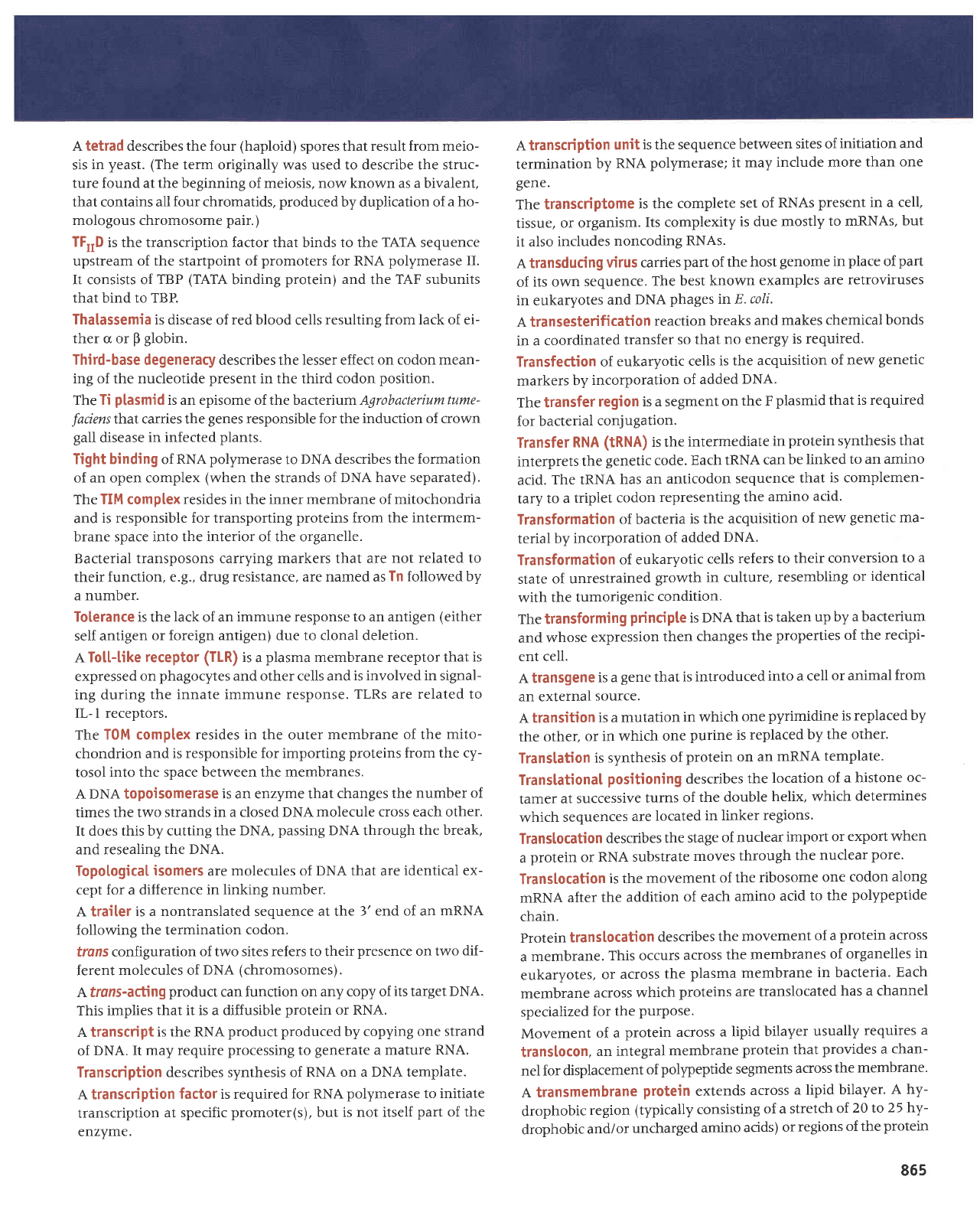
A tetrad describes the four
(haploid)
spores that
result from meio-
sis
in
yeast. (The
term originally was used to describe the struc-
ture found at the beginning of meiosis, now known as a bivalent,
that contains all
four
chromatids,
produced
by duplication of
a ho-
mologous chromosome
pair.
)
TFrrD
is the transcription factor that binds to the TATA sequence
upstream of the startpoint of
promoters
for RNA
polymerase
II.
It consists of
TBP
(TATA
binding
protein)
and
the
TAF subunits
that bind to TBP.
Thalassemia is disease
of
red
blood cells
resulting from lack of ei-
thersorBglobin.
Third-base
degeneracy describes the lesser effect
on codon mean-
ing of the nucleotide
present
in the third codon
position.
The Ti
plasmid
is an episome of the bacterium Agrobacterium
tume-
faciens
that carries the
genes
responsible
for
the
induction of crown
gall
disease
in infected
plants.
Tight binding of
RNA
polymerase
to
DNA describes the formation
of an open complex
(when
the strands of
DNA have separated).
The TIM complex
resides
in the inner
membrane of mitochondria
and
is responsible for transporting
proteins
from the
intermem-
brane space into the interior of the organelle.
Bacterial transposons carrying markers that are
not related to
their functior',
e.g., drug resistance, are named as
Tn followed by
a number.
Toterance is the
lack
of an
immune response to an antigen
(either
self antigen
or foreign antigen) due to clonal deletion.
A Totl-tike
receptor (TLR) is
a
plasma
membrane receptor that
is
expressed
on
phagocytes
and other cells and
is involved in signal-
ing during
the innate immune response.
TLRs are related to
IL-l receptors.
The TOM complex resides
in
the outer
membrane of the
mito-
chondrion and
is responsible for importing
proteins
from the cy-
tosol
into the space between the membranes.
A DNA topoisomerase
is an enzyme that
changes the
number of
times the two
strands in a closed DNA molecule
cross each other.
It does this by cutting the
DNA,
passing
DNA through
the break,
and resealing
the DNA.
TopologicaI
isomers
are
molecules of DNA that are
identical ex-
cept for a difference
in linking number.
A traiter
is a nontranslated sequence at the
3' end of an
nRNA
following the termination
codon.
trans configuration
of two sites refers to their
presence
on two
dif-
ferent
molecules of
DNA
(chromosomes).
A trans-acting
product
can function on
any copy of
its
target
DNA.
This implies
that it is a diffusible
protein
or RNA.
A transcript
is the RNA
product produced
by copying
one strand
of
DNA. It
may require
processing
to
generate
a mature
RNA.
Transcription
describes synthesis of
RNA on a DNA template.
A transcription
factor is required
for RNA
polymerase
to initiate
transcription
at specific
promoter(s),
but is not itself
part
of the
enzyme.
A transcription
unit
is
the
sequence
between
sites of
initiation and
termination
by
RNA
polymerase; it may include
more than
one
gene.
The transcriptome
is the
complete
set of
RNAs
present
in a cell,
tissue,
or organism.
Its complexity
is due mostly
to mRNAs,
but
it also
includes
noncoding
RNAs.
A
transducing
virus
carries
part
of the
host
genome in
place
of
part
of
its own
sequence.
The
best known
examples
are
retroviruses
in eukaryotes
and
DNA
phages
tn E.
coli.
A transesterification
reaction breaks
and
makes
chemical bonds
in a
coordinated
transfer
so
that
no energy
is required.
Transfection
of
eukaryotic
cells
is the acquisition
of new
genetic
markers
by
incorporation
of added
DNA.
The transfer
region
is a segment
on
the F
plasmid
that
is required
for
bacterial
conjugation.
Transfer
RNA
(IRNA)
is the
intermediate
in
protein
synthesis that
interprets
the
genetic
code.
Each tRNA
can
be linked
to an amino
acid.
The IRNA
has
an anticodon
sequence
that
is complemen-
tary
to a
triplet
codon
representing
the
amino
acid.
Transformation
of bacteria
is the
acquisition
of
new
genetic
ma-
terial
by incorporation
of added
DNA.
Transformation
of eukaryotic
cells
refers to their
conversion
to
a
state
of unrestrained
growth in culture,
resembling
or
identical
with
the tumorigenic
condition.
The transforming
principle
is DNA
that
is taken up
by a bacterium
and
whose
expression
then changes
the
properties of the recipi-
ent cell.
A transgene
is a
gene
that
is introduced
into a cell
or animal
from
an external
source.
A transition
is a mutation
in
which
one
pyrimidine is replaced
by
the
other,
or in which
one
purine
is
replaced
by the other.
Transtation
is synthesis
of
protein on an
mRNA
template.
Translational
positioning
describes
the
location
of a histone
oc-
tamer at
successive
turns
of
the double
helix, which
determines
which
sequences
are
located
in linker
regions'
Translocation
describes
the
stage
of nuclear
import or
export when
a
protein
or
RNA substrate
moves
through
the
nuclear
pore.
Translocation
is the movement
of the
ribosome
one
codon along
mRNA
after
the addition
of each
amino
acid to
the
polypeptide
chain.
Protein
translocation
describes
the
movement
of a
protein
across
a
membrane.
This occurs
across
the
membranes
of organelles
in
eukaryotes,
or
across
the
plasma membrane
in bacteria.
Each
membrane
across which
proteins are translocated
has a channel
specialized
for the
purpose.
Movement
of a
protein
across
a lipid
bilayer
usually
requires a
translocon,
an integral
membrane
protein
that
provides
a
chan-
nel
for displacement
of
polypeptide segments
across
the
membrane.
A transmembrane
protein
extends
across
a lipid
bilayer.
A hy-
drophobic
region
(typically consisting
of a stretch
of
20 to
25 }lly-
drophobic
and/or
uncharged
amino
acids)
or
regions
of the
protein
86s
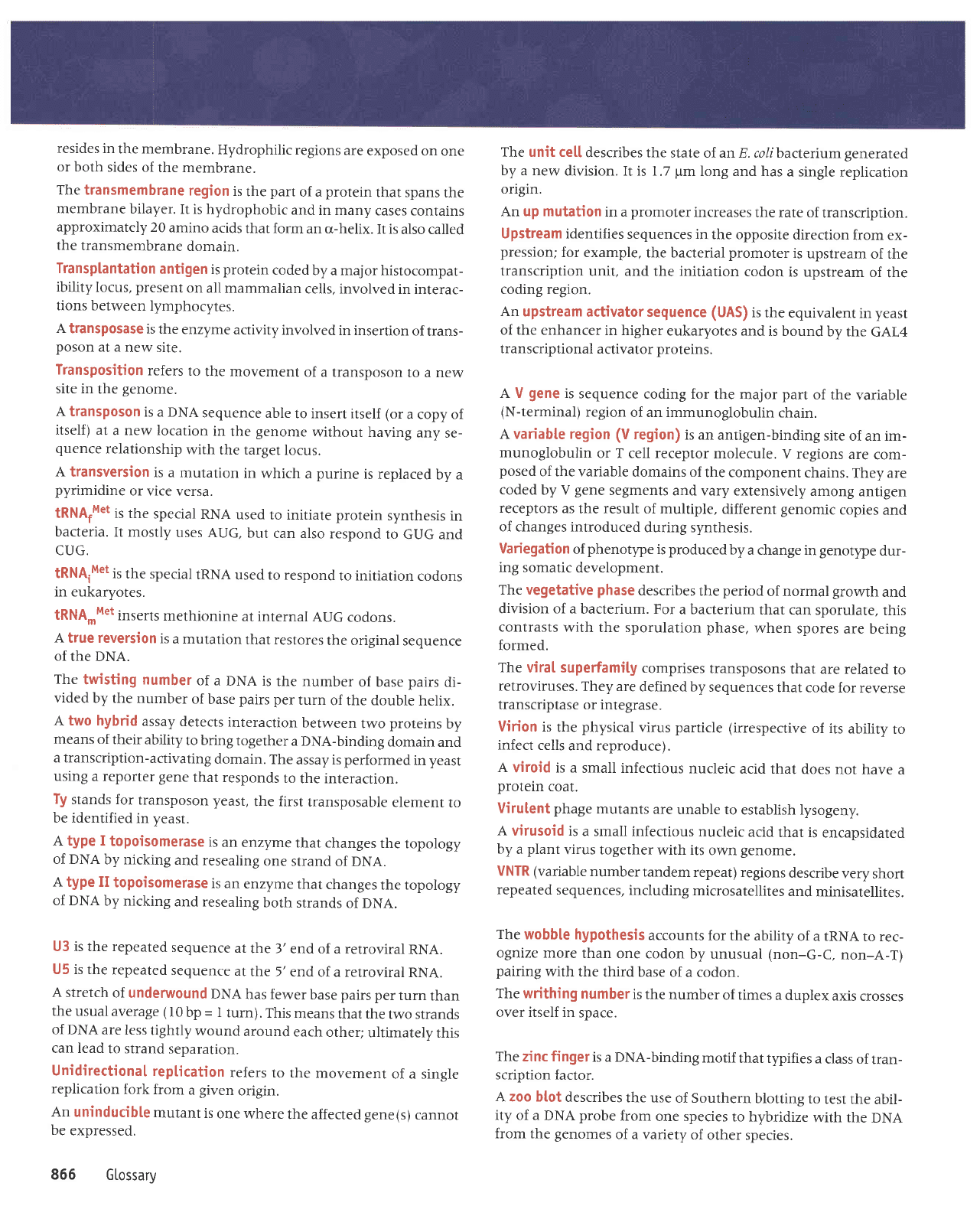
resides in
the membrane.
Hydrophilic
regions
are
exposed
on one
or both
sides of
the membrane.
The transmembrane
region
is
the
part
of a
protein
that spans
the
membrane
bilayer.
It is
hydrophobic
and
in many
cases contains
approximately
20
amino
acids
that form
an cr-helix.
It is
also called
the
transmembrane
domain.
Transplantation
antigen
is
protein
coded
by a major histocompat-
ibility
locus,
present
on
all mammalian
cells, involved
in interac-
tions between
lymphocytes.
A
transposase
is the
enzyme
activity
involved
in insertion
of
trans-
poson
at a
new site.
Transposition
refers
to
the movement
of a transposon
to a new
site in
the
genome.
A
transposon
is a DNA
sequence
able
to insert itself (or
a copy of
itself) at
a new location
in
the
genome
without
having
any
se-
quence
relationship
with
the target
locus.
A
transversion
is a
mutation
in
which
a
purine
is replaced
by a
pyrimidine
or vice
versa.
tRNAfMet
is the
special
RNA
used
to initiate
protein
synthesis
in
bacteria.
It mostly
uses AUG,
but
can also
respond
to
GUG and
CUG.
tRNAiMet is
the special
IRNA
used to respond
to initiation
codons
in eukaryotes.
tRNAmMet
inserts
methionine
at internal
AUG codons.
A
true reversion
is
a mutation
that restores
the original
sequence
of
the DNA.
The
twisting number
of a
DNA is
the number
of base
pairs
di-
vided
by the
number
of
base
pairs per
turn
of the double
helix.
A two hybrid
assay
detects
interaction
between
two
proteins
by
means of
their ability
to bring
together
a DNA-binding
domain
and
a transcription-activating
domain.
The
assay is
performed
in
yeast
using
a reporter gene
that responds
to
the interaction.
Ty
stands for
transposon yeast,
the first
transposable
element
to
be identified
in
yeast.
A type I
topoisomerase
is
an
enzyme
that changes
the
topology
of DNA
by nicking
and
resealing
one
strand
of DNA.
A
type II
topoisomerase
is an
enzyme
that
changes
the topology
of DNA
by nicking
and resealing
both
strands
of DNA.
U3 is the repeated
sequence
at
the l'end
of a retroviral
RNA.
U5 is the
repeated
sequence
at
the 5'
end
of a retroviral
RNA.
A
stretch
of
underwound
DNA
has fewer
base
pairs
per
turn
than
the
usual average (10
bp
=
I
turn).
This
means
that the
two strands
of DNA are
less
tightly
wound
around
each
other;
ultimately
this
can lead
to strand
separation.
Unidirectional
replication
refers
to rhe
movement
of a sinsle
replication
fork
from
a
given
origin.
An
uninducible
mutant
is
one
where
the affected
gene(s)
cannot
be
expressed.
The unit ce[[
describes the
state of an E. coli bacterium generated
by a new
division. It is 1.7
pm
long and has
a single
replication
origin.
An up mutation
in a
promoter
increases
the rate of
transcription.
Upstream identifies
sequences in
the opposite
direction
from ex-
pression;
for example,
the bacterial
promoter
is
upstream
of the
transcription
unit, and the initiation
codon
is upstream
of
the
coding region.
An
upstream
activator sequence (UAS)
is
the equivalent
in
yeast
of the enhancer
in higher
eukaryotes and
is bound
by the
GAL4
transcriptional
activator
proteins.
A V
gene
is
sequence
coding for
the major
part
of the
variable
(N-terminal)
region
of an immunoglobulin
chain.
A variabte region (V
region)
is an
anrigen-binding
site
of an im-
munoglobulin
or T cell receptor
molecule.
V regions
are
com-
posed
of the variable
domains of
the component
chains.
They are
coded
by V
gene
segments
and vary extensively
among
antigen
receptors
as
the result of multiple,
different
genomic
copies
and
of changes introduced
during synthesis.
Variegation
of
phenotype
is
produced
by
a change in
genotlpe
dur-
ing somatic
development.
The vegetative
phase
describes
the
period
of normal
growth
and
division of a
bacterium. For
a bacterium
that can
sporulate,
this
contrasts with
the sporulation phase,
when
spores
are being
formed.
The
viral superfamity
comprises
transposons
that are related
to
retroviruses.
They are
defined by
sequences
that code
for reverse
transcriptase
or integrase.
Virion is
the
physical
virus
particle
(irrespective
of its
ability
to
infect
cells
and reproduce).
A
viroid is a
small infectious
nucleic
acid that
does
not have
a
protein
coat.
Virutent
phage
mutants
are
unable to
establish lysogeny.
A
virusoid is
a small infectious
nucleic
acid
that is
encapsidated
by
a
plant
virus together
with its
own
genome.
VNTR
(variable
number
tandem
repeat) regions
describe
very
short
repeated
sequences,
including
microsatellites
and
minisatellites.
The
wobbte
hypothesis
accounts
for the
ability
of a IRNA
to rec-
ognize more
than
one codon
by unusual (non-G-C,
non-A-T)
pairing
with the
third base
of a codon.
The writhing
number
is the
number
of times
a duplex
axis
crosses
over itself in
space.
The
zinc finger
is a DNA-binding
motif
that typifies
a
class of
tran-
scription factor.
A zoo btot
describes
the use
of Southern
blotting
to
test the
abil-
ity of a
DNA
probe
from
one species
to hybridize
with rhe
DNA
from the
genomes
of a variety
of
other species.
866
Glossary
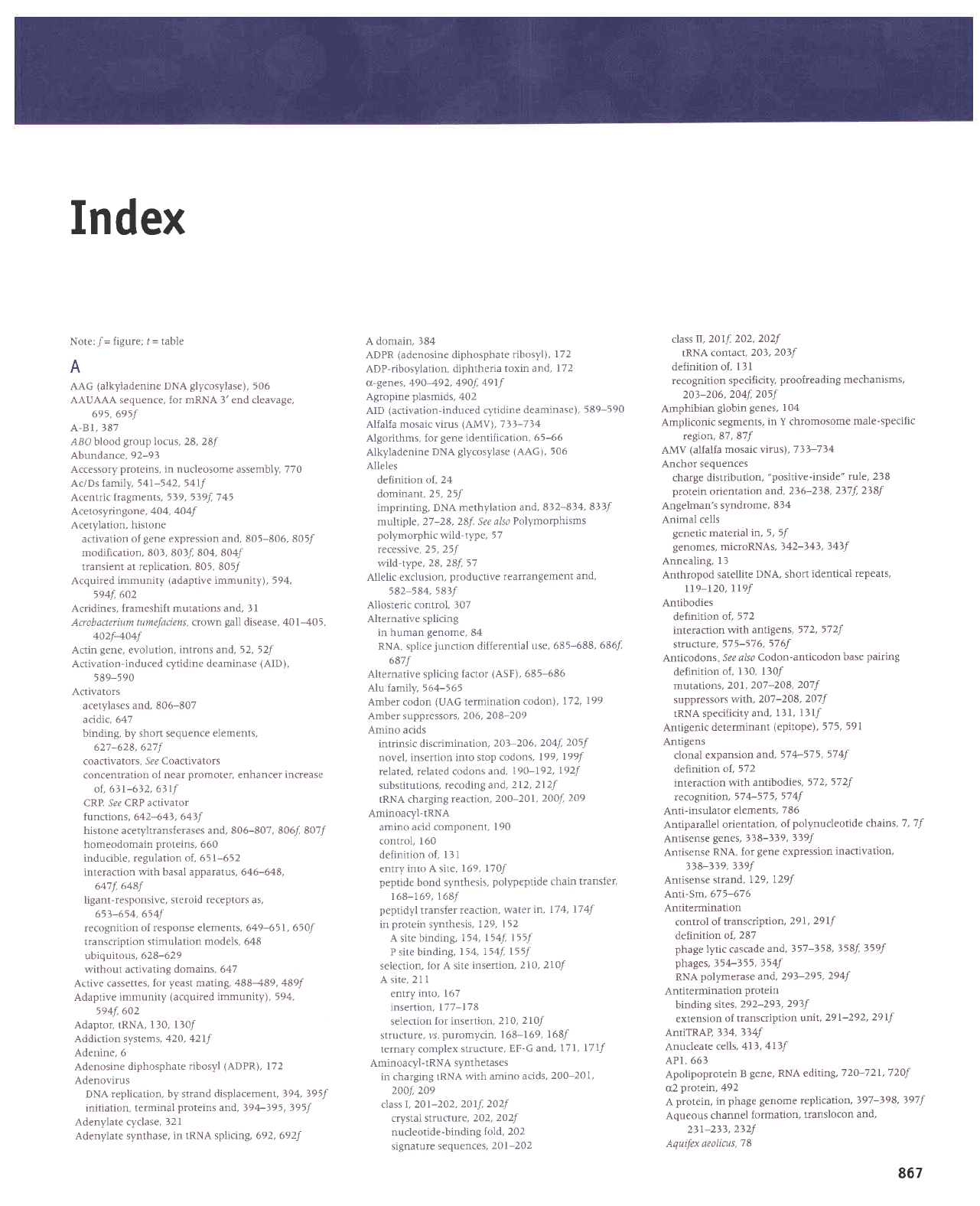
Index
Note:
/=
figuvg; 1
=
1261s
A
AAG
(alkyladenine
DNA
glycosylase),
506
AAUAAA sequence. lor mRNA 3'end cleavage.
695,695f
A-Bl, 187
.48O blood
group
locus. 28, 28/
Abundance, 92-91
Accessory
proteins,
in
nucleosome
assembly,
770
Ac/Ds family, 541-542, 54If
Acentric fragmen$,
5)9, 5j9f, 7 45
Acetosyringone,
404, 404f
Acetylation,
histone
activation of
gene
expression and, 805-806, 805/
modiiication,
8o), 8o1f,804, 804f
transient
at replication, 805, 805/
Acquired
immunity
(adaptive
immunity), 594,
5e4f,602
Acridines,
frameshilt mutations and, I I
Acrobacterium
tumefaciens, crown
gall
disease, 40l-4O5,
402f-4o4f
Actin
gene,
evolution,
introns and, 52, 52l
Activation-induced
cytidine deaminase
(AID),
589-5
90
Activators
acetylases
and, 806-807
acidic,
647
binding. by short sequence
elements,
627-628,627f
coactivators
S?s Coactivalors
concentration
of near
promoter,
enhancer
increase
of,6)I-612,6)lf
CRP
see CRP activator
functions, 642-641,
64)f
histone acetyltrans{erases
and, 806-807, 806f, 807f
homeodomain
proteins,
660
inducible, regulation
of
,
65 I
-652
interaction with
basal apparatus, 646-648,
647f,648f
ligant-responsive,
steroid receptors as,
653-654,654f
recognition
of response elements, 649-651,
650f
rranscription stimulation
models, 648
ubiquitous,
628-629
without activating
domains, 647
Aclive cdssettes.
for
yeast
mating,
488489.489f
Adaptive
immunity
(acquired
immunily),
594.
5e4f,602
Adaptor, IRNA, I30,
ll0/
Addiction syslems,
42O, 42lf
Adenine, 6
Adenosine
diphosphate
ribosyl
(ADPR),
172
Adenovirus
DNA
replication, by strand
displacement, )94, )9rf
initiation, terminal
proteins
and, )9 4-)9 5, 795f
Adenylate
cyclase, 321
Adenylate
synthase,
in IRNA splicing, 692, 692f
A domain, 184
ADPR
(adenosine
diphosphate
ribosyl),
172
ADP-ribosylation, diphtheria
toxin and,
172
cr-genes, 49 O49 2, 490f
,
49 1
f
Agropine
plasmids,
402
AID
(activation-induced
cytidine
deaminase),
589-590
Alfalfa mosaic virus
(AMV),
7))-734
Algorithms, for
gene
identificaion,
65-66
Alkyladenine
DNA
glycosylase
(AAG), 506
Alleles
definition
of, 24
dominant,25,25f
imprinting, DNA methylation
and',
8)2-8)4,
833f
multiple, 27-28,
28f . See a/so
Polymorphisms
polymorphic
wild-type,
57
recesslve, z), z)_I
wild-type,
28,28f,57
Allelic exclusion,
productive reartangement
and,
582-584,58)f
Allosteric control,
107
Alternative splicing
in human
genome.
84
RNA, splice
junction
differential
use, 685-688,
686f,
687f
Alternative splicing
factor
(ASF),
685-686
Alu family, 564-565
Amber codon
(UAG
termination
codon),
172,
199
Amber suppressors,
206, 208-209
Amino acids
intrinsic discrimination,
203-206,
204f,
2o5f
novel, insertion into stop
codons,
199,
l99f
related. related codons
and,
l9o-l'92,
l92f
substitutions,
recoding and,
212, 2l2f
IRNA charging
reaction,
200-201,
200f,2O9
Aminoacyl-IRNA
amino
acid component,
190
control,160
definition
of, Il1
entry
into A site, 169,
l70f
peptide
bond synthesis,
polypeptide chain transfer,
t68-r69,
r68f
peptidyl
transfer
reaction,
water
in, 17
4, 174f
in
protein
synthesis.
1.29,
152
A
sile
binding.
154. 154[.
t55f
P site binding.
154. l14f.
l55f
selection,
for A site
insertion,
21o,210f
Asite,211
entry
into. 167
insertion.177-178
selection
Ior insertion,
210,
2l0f
structure,
vJ
puromycin, 168-169,
l68f
ternary complex
structure,
EF-G
and, 171'
lTlf
Aminoacyl-tRNA
synthetases
in charging IRNA
with amino
acids,
200-201,
200f,20e
class
I, 201-202,
2olf,202f
crystal structure,
202,
2O2f
nucleotide-binding
f old,
202
signature sequences,
20 I
-202
class II,
20ll 202,2O2f
IRNA
contact,
20),203f
de{inition
of,
131
recognition
specilicity,
proofreading mechanisms,
20)-206,
204f,
205f
Amphibian
globin genes, i04
Ampliconic
s€gments,
in Y chromosome
male-specific
rcgio\,87,87f
AMV
(alfalfa mosaic virus),
7)3-734
Anchor sequences
charge distribution,
"positive-inside"
rule, 218
protein orientation
and,
276-2)8,
237f, 2)8f
Angelman's
syndrome,
834
Animal
cells
genetic material
in, 5, 5/
genomes, microRNAs,
j42-343,
j4)f
Annealing,
I3
Anthropod
satellite
DNA, short
identical
repeats,
'119-120,
ll9f
Antibodies
definition
of,
572
interaction
with
antiger.s,
57 2, 57
2f
structure,
t />-)
/6, ) /oJ
Anticodons
See also
Codon-anticodon
base
pairing
definition
oI,
130, L)of
mutations,
2Ol, 207
-20
8, 207
f
suppressors
with,
2o7-208,
207f
IRNA specificity
and,
1 31,
I
3fl
Antigenic
determinant
(epitope), 57 5,
591
Antrgens
cf
onal expansion
and,
57 4-57
5, 57 4[
definition
of, 572
interaction
with
antibodies,
57
2, 57 2f
recognition,
rT
4-57 5,
57 4f
Anti-insulator
elements,
786
Antiparallel
orientation,
oI
polynucleotide chains,
7,
T
Antisense
genes,
338-))9,
j)9f
Antisense
RNA,
for
gene
expression
inactivation,
))8-139,
j)9f
Antisense
slland,,
I29, I29f
Anti-Sm,
675-676
Antitermination
control
of transcription,
29I,
29 If
definition
oi,
287
phage
lytic cascade
and,
)57-758,
)58f,359f
phages,
754-)55,
354f
RNA
polymerase and',
29)-295,
29 4f
Antitermination
protein
binding
sites,
292-29 ),
2931
extension
of transcription
unit,
29 l-292,
29 lf
AntiTRAP,
734,
))4f
Anucleate
cells,
413,
4l3f
APt,663
Apolipoprotein
B
gene,
RNA editing,
720-721
'
720f
a2
prctern,
492
A
protein, in
phage
genome replication,
)97-J98,397f
Aqueous channel
formation,
translocon
and,
2)r-2)),2)2f
Aquifex aeolicus,
TS
867
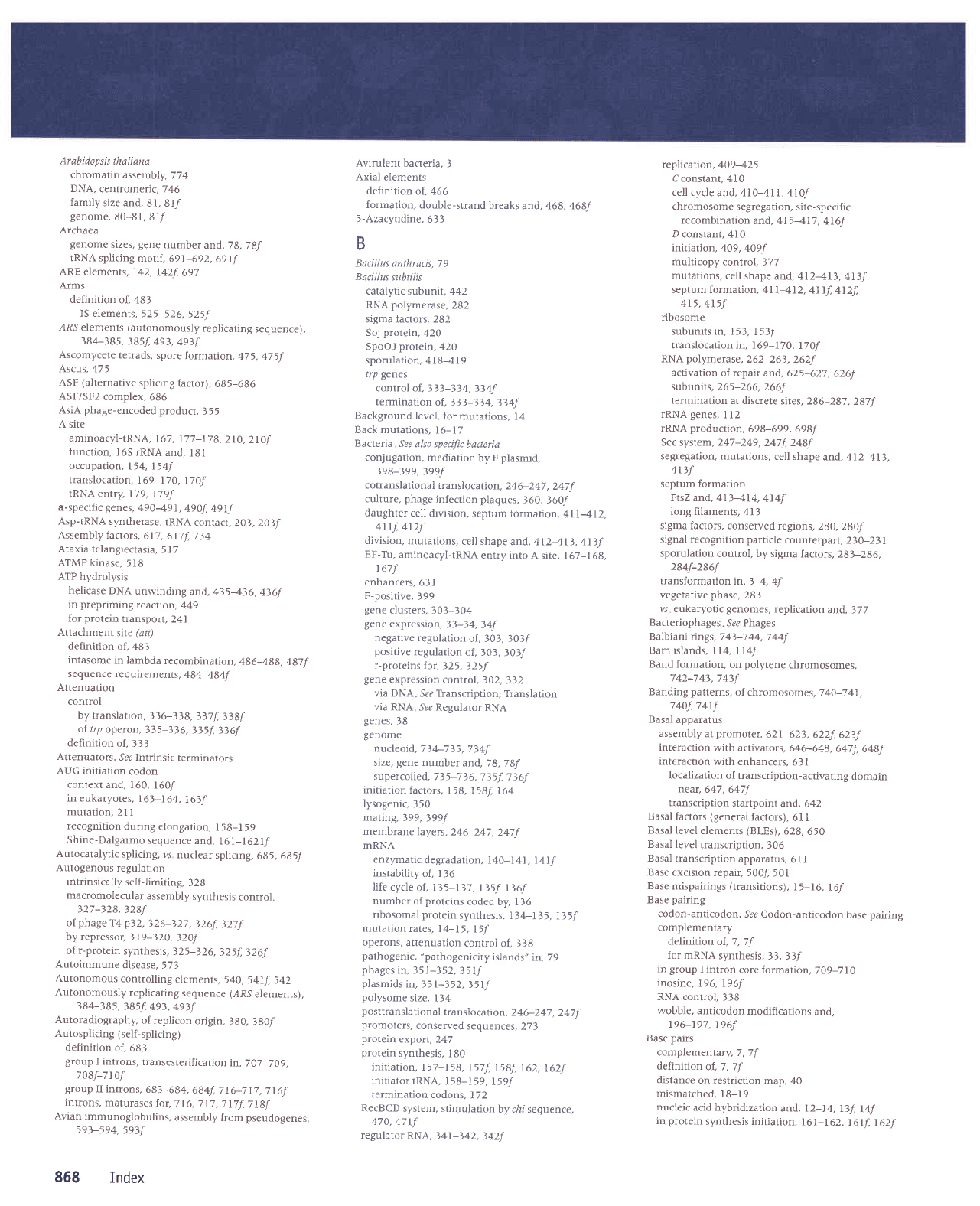
Arabidopsis
thaliana
chromatin
assembly,
774
DNA,
centromeric,
746
family
size and,
81, 8l/
genome,
80-8f, 8U
Archaea
genome
sizes,
gene
number
and,78,78f
IRNA splicing
moldf,
691-692,
69tf
ARE
elemenrs, t42,
I42f,697
Arms
definition
of. 483
IS elemenrs,
525-526,
525f
ARS
elements
(autonomously
replicating
sequence),
)84-385.
)85f, 49),
493f
Ascomycete
tetrads,
spore
formation,
47 5,
47
jf
Ascus, 475
ASF
(alternative
splicing
factor),
685-686
ASF/SF2
complex,
686
AsiA
phage-encoded
product,
3 5 5
A slte
aminoacyl-IRNA,
t67,
177-t78,
2tO,
2tof
function,
l65 rRNA
and,
l8l
occupation,
154, l54f
translocation,
| 69-17
0, 17
0f
IRNA entry, 179,
179f
a-specific
genes,
490491,
49Of, 49If
Asp-IRNA
syntherase,
IRNA
conract.
2$,2jlf
Assembly factors,
617
,
6t7f,7)4
Ataxia
telangiectasia,
5 l7
ATMP kinase.
518
ATP
hydrolysis
helicase
DNA
unwinding
and,
4J5476,
B6f
in
prepriming
reaction,
449
for
protein
transport.
241
Attachment
site
(41,
de{inition of,
481
intasome
in lambda
recombin
aIron, 486488,
487
f
sequence requirements,
484,
484f
Attenuation
control
by translation,
))6-))8,
17f, ))Sf
of trp
operon,
))5-)36,
tif,
t6f
definition
of, 133
Attenuators.
See Intrinsic
terminators
AUG initiation
codon
context
and, 160,
l6of
in eukaryotes,
l6)-164,
16Jf
mutation,
21 I
recognition
during
elongation,
I 58-l
59
Shine-Dalgarmo
sequence
and,
I6l-l62lf
Autocatalytic
splicing,
vs
nuclear
splicing,
685,
685/
Autogenous
regulation
intrinsically
self
-limiring,
128
macromolecular
assembly
synthesis
control,
)27-)28,
)28f
of
phage
T4
p32,
)26-j27,
)26f,
)27f
by
repressor,
)19-J20,
)2Of
of r-protein
synthesis,
325-)26,
j25f,
)26f
Autoimmune
disease,
571
Autonomous
controlling
elements.
540,
j4lf,
j42
Autonomously
replicating
sequence (,4RS
elements),
384-385,
)85f,
49), 49)f
Autoradiography.
of replicon
origin,
380, 380/
Autosplicing (self
-splicing)
definition
of. 683
group
I introns,
transesredfication
in, 7
07
-7
09,
7 o8f-7
tof
group
II introns,
683-684,
684f, 7
16-7 1 7,
7 I6f
introns,
maturases
for, 7 I
6, 717, 717f,7
l8f
Avian
immunoglobulins,
assembly
f rom pseudogenes,
593-594,593f
Avirulent
bacteria,
l
Axial
elements
definition
of, 466
formation.
double-strand
breaks
and, 468, 468f
5-Azacytidine,633
B
Bacillus anthracis,
T9
Bacillus
subtilis
catalytic subunit,
442
RNA
polymerase,
282
sigma factors, 282
Soj
protein,
420
SpoOJ
protein,
420
sporulation,
418419
trp
genes
control of, 1))-j34,
))4f
termination
of,
33)
-))
4,
33
4f
Background
level, {or
mutations, l4
Back mutations,
I6-17
Bacteria See
also specific
bacteria
conjugation, mediation
by
F
plasmid,
)98-399,
)99f
cotranslational
translocation,
246-247,
247
f
culture,
phage
infection
plaques,
360,360f
daughter cell
division,
septum formarion,
4ll412,
41rf,4t2f
division,
mutations,
cell shape
and, 412413, 417f
EF-Tit.
aminoacyl-tRNA
entry into A
site, 167-168,
r67f
enhancers,
6l I
F-positive,
399
gene
clusrers,
70]-)04
gene
expression,
j)-)4,
34f
negative regulation
of, 30), )jJf
positive
regulation
of, )OJ,30)f
r-proteins
for,
)25, i25f
gene
expression
con1trol JO2,
)32
via DNA
See Transcription;
Ttanslation
via
RNA See
Regulator RNA
genes,
38
genome
nucleoid, 7
)4-7j5, 734f
size,
gene
number
and, 78.
78/
supercoiled.
7 J5-7
36, 7
j5f,
7
)6f
initiation
factors,
I 58, 158f,
164
lysogenic,350
mating,
)99,
)99f
membrane
layerc,
246-247,
247f
mRNA
enzymatic
degradation,
140-I41, l4lf
instability
of, I
l6
life cycle
of, I)5-137,
B5f, l36f
number
of
proteins
coded
by, I 36
ribosomal protein
synthesis,
I34-l]5,
fJ5f
mutation
rates, l4-15,
l5l
operons,
attenuation
control
oI, ll8
pathogenic, "pathogeniciry
islands"
in, 79
phages
in, i5l-j52,
JSlf
plasmids
in, )51-)52,
15lf
polysome
size,
l)4
posttranslational
translocation,
246-247,
247f
promoters,
conserved
sequences,
271
protein
exporr,
247
protein
synthesis,
180
initiation,
157-158,
t57f,
t58f, t62,162f
initiator
IRNA,
158-159,
l59f
termination
codons,
172
RecBCD
system. stimulation
by cftr sequence,
47O,47rf
regularor
RNA,
34 |
-J4
2,
3421
replication,
409425
C constant,
4I0
cell cycle
and, 4I04lI,4l0f
chromosome
segregation,
site-specific
recombination
and 415417,
416f
D constant, 41 0
initiation,
409, 4O9f
multicopy control,
177
mutations,
cell shape
and, 41241),
4Bf
septum formation, 411412,
411f,
412f,
4t5,415f
ribosome
suDunlrs rn, 1>t,
I)tJ
translocation in, 169-170,
170f
RNA
polymerase,
262-26J, 262f
activation of repair
ar'd, 625-627,
626f
subunits, 265-266, 266f
termination
at discrete
sites, 286-287,
287f
rRNAgenes,
ll2
IRNA
production,
698-699,
698f
Sec system, 247
-249,
247
f,
248f
segregation, mutations,
cell shape
and, 412-48,
4r)f
septum formation
FtsZ and, 413414,414f
long filaments,4Il
sigma factors, conserved
regions,
280, 28Of
signal recognition particle
counterpafi,
2jO-2)l
sporulation
control, by sigma
lactors,
28)-286,
284f-286f
transformation
in, )4,
4f
vegetative
phase,
283
vJ eukaryotic
genomes,
replication
and, )77
Bacteriophages
See Phages
Balbiani rings, 7
43-7 44, 7 44f
Bam islands,
114,114f
Band formation,
on
polytene
chromosomes,
742-74),743f
Banding
patterns,
of chromosomes,
7 40-7 41,
74of,741f
Basal
apparatus
assembly
at
promoteL
621-62),
622f,
6nf
interaction with
activators,
646-648,
647
f,
64Sf
interaction
with enhancers,
63 I
localization
of transcription-activating
domain
neaL
647, 647f
transcription
startpoint
and, 642
Basal factors (general
factors),
6 I I
Basal level
elements
(BLEs),
629,
650
Basal level
transcription,
106
Basal
transcription
apparatus,
6l I
Base excision
repaia 5001
50i
Base
mispairings
(transitions),
l5-16,
I6f
Base
pairing
codon-anticodon.
See Codon-anticodon
base
pairing
rnmnlampnr'
",
definirion
of, 7, 7/
for mRNA
synthesis,
31, I]/
in group
I intron
core formation,
709-710
inosine,
1 96, 1
96l
RNA control,
ll8
wobble,
anticodon
modifications
and,
t96-197,
r96f
Base pairs
complementary,
7,
4
delinition
of, 7,
T
distance
on restriction
map, 40
mismatched,
I8-19
nucleic
acid hybridization
and. I2-I4,
tJf,
\4f
in protein
synthesis initiation,
l6I-162,
t6If,
l62f
868
Index
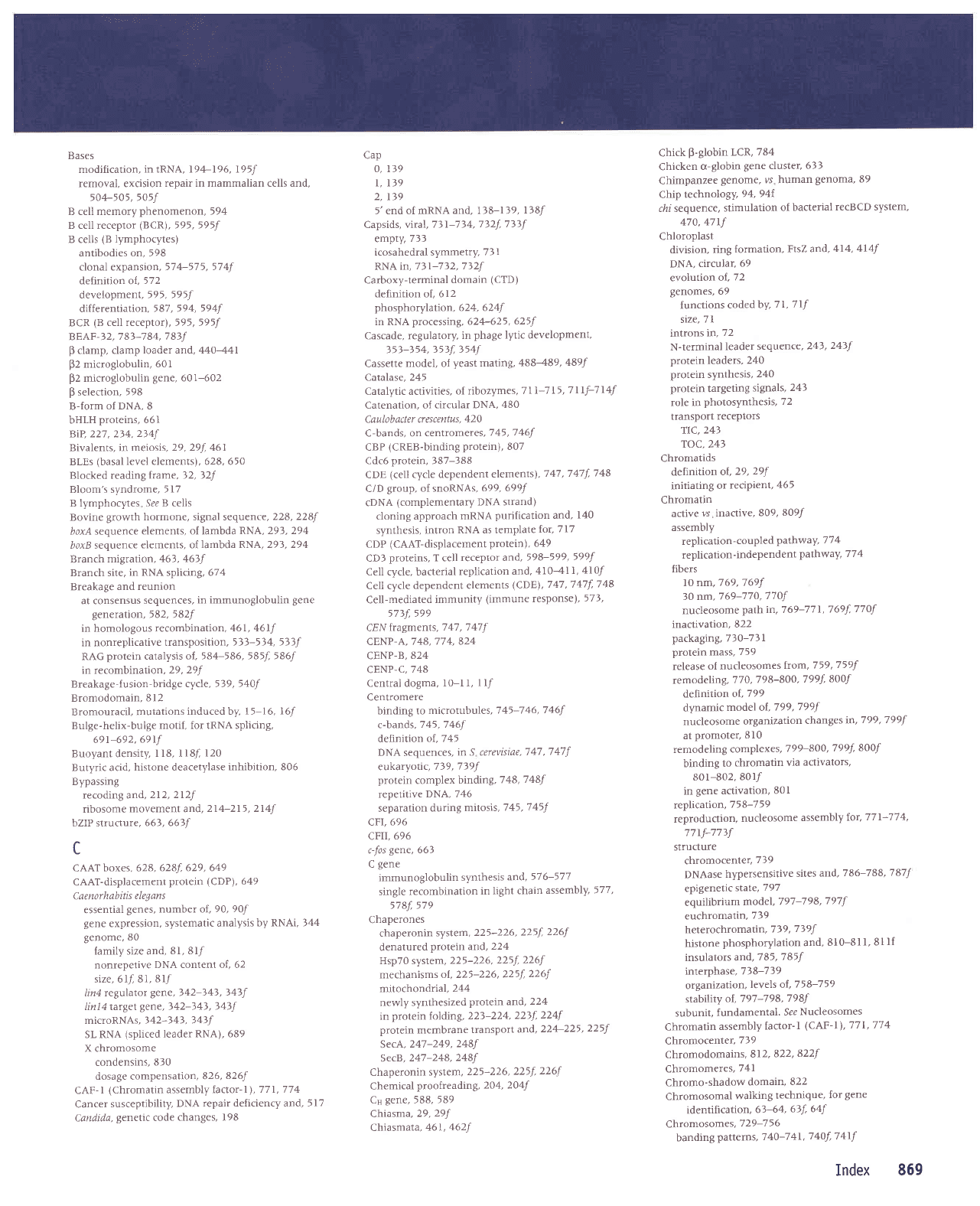
Bases
modification,
in IRNA, 194-196, I95f
removal, excision
repair in mammalian cells and.
504-505,505f
B cell memory
phenomenon,
594
B cell receptor
(BcR),
595, 595/
B cells
(B
lymphocytes)
antibodies on, 598
clonal expansion, ,7
4-57 5, 57 4f
oennltron 01,
) /z
development,
595,595f
differentiation,
587, 594, 594f
BCR
(B
cell receptor), 595,595f
BEAF-32,
78)-784,78)f
p
clamp, clamp
loader and, 440441
p2
microglobulin,
601
p2
microglobulin
gene,
601-602
B
selection,
598
B-form
of DNA, 8
bHLH
proteins,
661
BiP, 227,2)4,2)4f
Bivalents, in
meiosis, 29,29f,461
BLES
(basal
level elements), 628,650
Blocked reading
frcme, )2, )2J
Bloom's syndrome,
5I7
B lymphocytes
See B cells
Bovine
growth
hormone, signal sequence,
228,228f
lox.4 sequence
elements. of lambda
RNA,293,294
loxB sequence
elements, of
lambda RNA, 291, 294
Branch
migration
,
46J, 46)f
Branch site,
in RNA splicing, 674
Breakage
and reunion
at consensus
sequences,
in immunoglobulin
gene
generation,
582, r82f
in
homologous recombination,
461, 46l,f
in nonreplicative
transposition,
5j]-5j4, 533f
RAG
protein
catalysis of,
584-586, 585f, 586f
in recombination,
29, 29f
Breakage-fusion-bridge
cycle, 5)9, 540f
Bromodomain,
Sl2
Bromouracil,
mutations
induced by, I5-16,
16f
Bulge-helix-bulge
motif, for tRNA splicing,
69t-692,69If
Buoyant density,
I 18. ll8f.
l2o
Butyric acid,
histone deacetylase
inhibition, 806
Bypassing
recoding and,2l2,2l2f
ribosome
movement and,
214-215, 214f
bZIP structure,
66), 663f
C
CAAT
boxes, 628,
628f, 629, 649
CAAT-displacement
protein
(CDP).
649
Caenorhabitis
elegans
essential
genes,
number of,
90, 90/
gene
expression,
systematic analysis
by RNAi. 344
genome,
80
family size and,
81, 8l/
nonrepetive
DNA content of, 62
size, 6ll 81,
8r/
lin4 rcgl]lator
gene,
)42-)43,
)4)f
linl4target
gene,
)42-)4), )43f
microRNAs,
)42-)4), 34)f
SL RNA
(spliced
leader
RNA), 689
X chromosome
condensins,
830
dosage compensal\on,
826,
826f
CAF-l
(Chromatin assembly factor-ll,
77 l, 774
Cancer
susceptibility,
DNA
repair deficiency and, 5
I 7
Candida,
genetic
code
changes, t98
cap
o, t)9
r, t)9
2, t)9
5' end oI mRNA
and, 1 38-l 39,
I 38/
Capsids, viral,
7)l-714,
7)2f, 7))f
empty,
733
icosahedral symme:uy,
7
jl
F.NA.in,
7)l-732, 7)2f
Carboxy-terminal
domain
(CTD
)
definition of, 612
phosphorylation, 624, 624f
in RNA
processing,
624-625,
625f
Cascade, regulatory,
in
phage lytic development,
75j-)54,
j5)f,
)54f
Cassette
model, of
yeast mating,
488489,
489f
Catalase,245
Catalytic activities,
of ribozymes.
7
1'1-7 15,
7 llf-7
14f
Catenation, of
circular DNA,
480
C aulo b acter ff e
scentus, 420
C-bands, on
centromeres,
745,746f
CBP
(CREB-binding
protein),
807
cdc6
protein,
j87-J88
CDE
(cell
cycle dependent
elements),
747
,747f,
748
C/D
group,
of snoRNAs,
699,699f
cDNA
(complementary DNA srrand)
cloning approach
nRNA
purification and,
140
synthesis, intron
RNA as template
for,
717
CDP
(CAAT-displacement
protein), 649
CDI
proteins,
T cell
recepror and,598-599,599f
Cell cycle, bacterial
replication
and,
410--41
i, 410/
Cell cycle
dependent elements
(CDE), 747
,
747f,748
Cell-mediated
immunity
(immune response),
571,
57jf,599
CENfragments,
747, 7 47f
CENP-A,
748,774,824
CENP-B,824
CENP-C,
748
Central dogma,
I0-l 1,
I t/
Centromere
binding to
microtubules,
7 45-746,
7 46f
c-bands,7
45, 7 46f
definition
of, 745
DNA sequences,
in S cerevisiae,
7 47,
7 47f
eukaryotic,
7)9,
719f
protein
complex
binding,748,
748f
repetitive
DNA, 746
separation
during
mftos\s,
7 45,
7 45f
cFl,696
CFII,
696
c-fos
ge\e,
663
C
gene
immunoglobulin
synthesis
and,
57 6-577
single
recombination
in light
chain
assembly,
577,
57 8f, 579
Chaperones
chaperonin
system,
225-226,
225f,
226f
denatured
protein
and,
224
Hsp70 system,
225-226,
225f,
226f
mechanisms
of. 225-226,
225f,
226f
mitochondrial,
244
newly synthesized
protein and,
224
in
protein
folding,
223-224,
22)f,
224f
protein
membrane
transport
and,
224-225
'
225f
SecA,
247-249,
248f
SecB,
247-248,
248f
Chaperonin
system,
225-226,
225f,
226f
Chemical
proofre
ading,
2O4, 204f
Cs
gene,
588,
589
Chiasma,29,29f
chiasmata,
46I,462f
Chick
p-globin
LCR,
784
Chicken
c-globin
gene
cluster,
631
Chimpanzee
genome,
vs human
genoma,
89
Chip
technology,
94, 94f
chl sequence,
stimulation
of
bacterial
recBCD system,
470,471f
Chloroplast
division,
ring
formation,
FtsZ and,
414, 4l4f
DNA,
circular,
69
evolution
of,
72
genomes, 69
functions
coded
by,71,7
lf
size,
7 |
introns
in,
72
N-terminal
leader
sequence,
24J,
24)f
protein
leaders,
240
protein
synthesis,
240
protein
targeting
sigrials,
24)
role in
photosYnthesis,
72
transport
receptors
Trc,243
TOC,243
Chromatids
defiaitio\
ot,
29,
29f
initiating
or
recipient,
465
Chromatin
active
vs inactive,
809,
809f
assembly
replication-couPI
ed
P
alhw
aY, 7
7 4
replication-independent
pathway, 774
fibers
1O nm,
7 69, 7 69f
30 rlm,769-770,770f
nucleosome
path it, 7 69-77
l, 7 69f'
770f
inactivation,
822
packaging, 730-7)l
protein mass,
759
release
of nucleosomes
from,
759,759f
remodeling,
7 7 0,
7 9 8-800,
7 99f
'
8o0f
definition
oI,
799
dynamic
model o1,799,
799f
nucleosome
organization
changes
in,
799, 799f
at
promotet 810
remodeling
complexes,
799-800,
799f'
8O0f
binding
to
chromatin
via
activators,
80r-802,80u
in
gene
activation,
80
I
replication,
758-759
reproduction,
nucleosome
assembly
for,
77 l-77 4,
77rf-77)f
structure
chromocentet
719
DNAase
hypersensitive
sites
and',
7
86-7
88,
7 87
f
epigenetic
state,
797
equilibrium
mod
el, 7
97
-7
98,
7 97
f
euchromatin,
719
heterochromatin,
7J9,
7
j9f
histone
phosphorylation
and,
810-81
l' 8
I lf
insulators
and,
785,
785f
interphase,
7)8-7)9
organization,
levels of,
758-759
stabiliry
of,
797
-798,
7 98f
subunit,
fundamental.
See
Nucleosomes
Chromatin
assembly
factor-
1
(cAF-
I
),
77 |
'
77
4
chromocenter,
739
Chromodomains,
812,
822,
822f
Chromomeres,
741
Chromo-shadow
domain,
822
Chromosomal
walking
technique,
{or
gene
identification,
6j-64,
6jf, 64f
Chromosomes,
729-756
banding
patterns, 740-741,
7 4of' 7 41f
Index
869
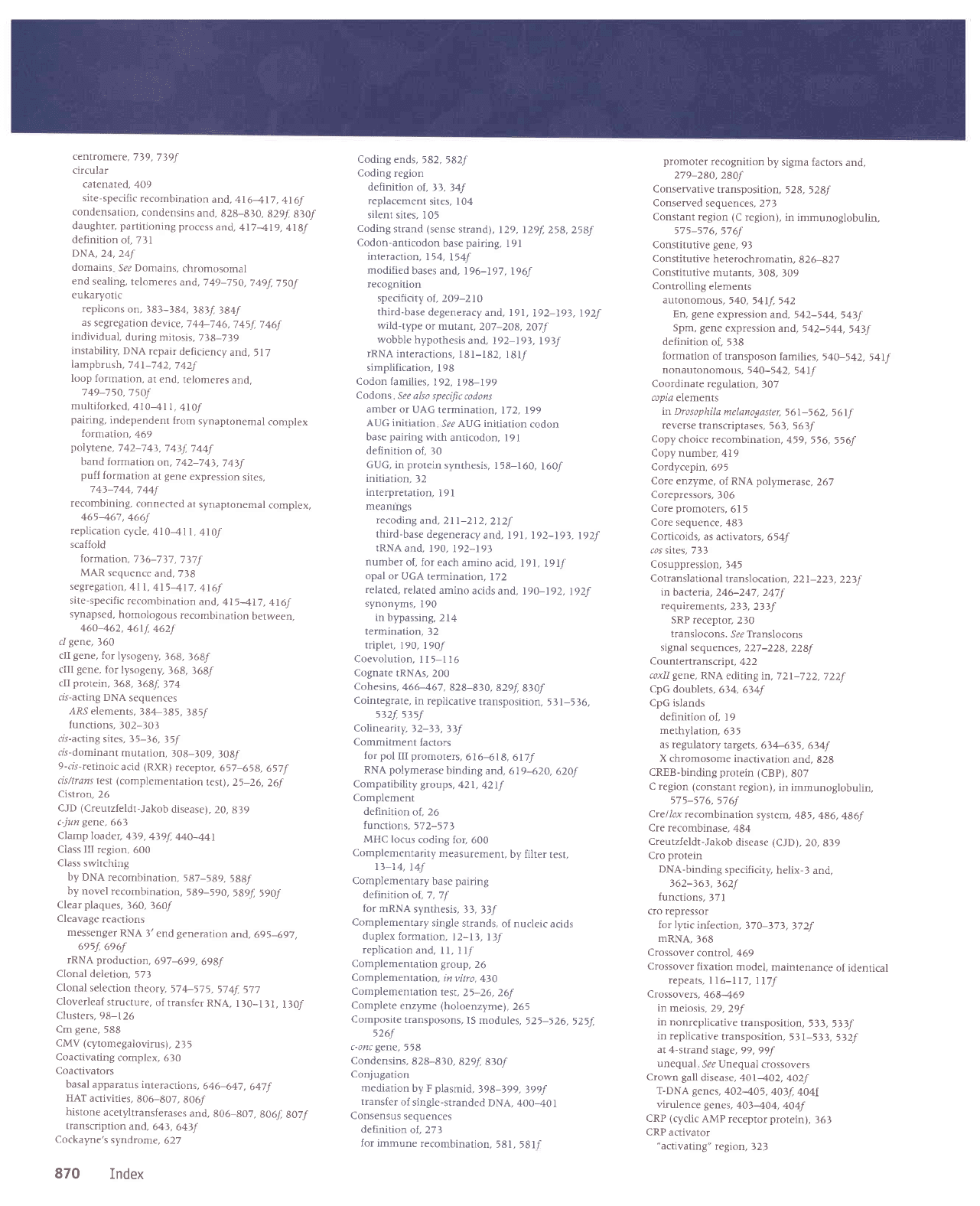
centromere,
7)9,7j9f
circular
catenated,
409
site-speciiic
recombination
and, 416417,
416f
condensation,
condensins
and,
828-810,
S2gf,
gl}f
daughter,
partitioning
process
and,
4l74lg,
4lgf
oelrnltron
oI, /J1
DNA,24,24f
domains
Ses Domains,
chromosomal
end
sealing,
telomeres
and, 749-7jO,
749f,75Of
eukaryotic
replicons
on, )87-)84,
)$f,
)84f
as
segregation
device,
744-746,745f,
746f
individual,
during
mitosis,
7
)B-779
instability,
DNA
repair
deficiency
and,
5 I 7
lampbrush,
7
4l-7 42,
7 42f
loop formation,
ar end,
telomeres
and,
749-750,750f
multiforked,
41041
I,
4tOf
pairing,
independent
from
synaptonemal
complex
tormation,469
polytene,
7 42-7
4), 7
4)f, 7
44f
band
formation
on,
742-7
4), 74)f
puff
formation
at
genc
expression
sites.
74)-744,744f
recombining,
connected
at
synaptonemal
complex,
465467,
466f
replication
cycle, 4l
0-41 l,
410/
scaffold
formation,
7)6-737,
7j7
f
MAR
sequence
and,
718
segregation,
4l
l, 415417
,
4t6f
site-specific
recombination
and,
4lj4I7,
416f
synapsed,
homologous
recombination
berween,
460462,
46tf,
462f
cI
ge^e,
)60
cII
gene,
for
lysogeny,368,
J68f
CIII
gene,
for
lysogeny,
)68, )6Bf
cII
prorein,
368, )68f,374
cr-acting
DNA
sequences
,4RS elements,
784-j85,
)85f
functions,
302-)03
crj-acting
siIes, J5-)6,
)5f
ds-dominant
mutation,
308-109,
108/
9-crs-retinoic
acid
(RXR)
receptor,
6j7-6j5,
6j7f
cis/trans Iest
(complementarion
lestl,
25-26,
26f
Cistron,
26
CJD
(Creutzfeldt-Jakob
disease),
20,
839
c-Jun gene,
66)
Clamp loader,
439,
89f,
440441
Class III
region,
600
Class switching
by
DNA recombinarion,
587-589,
588/
by
novel recombination,
589-5gO,
jS9f,
5g0f
Clear
plaques,
)60,
36Of
Cleavage
reactions
messenger
RNA 3'
end
generation
and,
695_697,
695f,696f
rRNA
producrion,
697-699,
698f
Clonal deletion,
571
Clonal selection
rheory,574-575,
174f,
j77
Cloverleaf
structure,
of
transfer
RNA,
ll0-lll,
Il0/
Clusters,
98-l
26
Cm
gene,
588
CMV (cytomegalovirus),
215
Coactivating
complex,
630
Coactivators
basal apparatus
interactions,
646-647,
647f
HAT
activities,
806-807,
806/
histone
acetyltransferases
and,
806-807,
SO6f,
SOTf
transcription
and,
68,
64jf
Cockayne's
syndrome,
627
870
Index
Coding ends,
582, 582f
Coding
region
definition
of, )),34f
replacement
sites, 104
silent sites, 105
Coding
strand
(sense
strand),
t29, 129f,258,255f
Codon-anticodon
bas€
pairing,
l9l
interaction,
154,
l54f
modified
bases and,, 1,96-t97,
t96f
recognition
specificity
of. 209-210
third-base
degeneracy
and, t9t,
192-\93, t92f
wild-type
or mutanr,
207-2O8,207f
wobble hypothesis
and, 19 2-19
3, 19 1f
rRNA
interacrions,
l8l-182,
l8I/
simplification,
198
Codon families,
192,
198-199
Codons
See also specific
cod.ons
amber
or UAG
termination,
172,
199
AUG initiation
See AUG initiation
codon
base
pairing
with
anticodon, l9l
definition
of, 30
GUG, in
protein
synrhesis.
158-160,
160/
initiation,
l2
interpretation,
I 9l
meanlngs
recoding
and,
2ll-212,
2t2f
third-base
degeneracy
and, t9t, 192-1%,
t92f
IRNA
and, 190,
192-193
number
of, for
each amino
acid, l9l,
l9tl
opal
or UGA termination,
172
related,
related
amino
acids
and, l9O-192,
\92f
synonyms,190
in bypassing,
214
termination,
J2
triplet, 190.190/
Coevolution,
II5-l16
Cognate tRNAs,
200
Cohesins,
466467,
828-810,
829f,
83Of
Cointegrate,
in replicative
transposition, 5fl-r36,
5)2f,535f
Colinearity.
32-33,
)jf
Commitment
factors
for
pol
III
promoters,
616-618,
6I7f
RNA
polymerase
binding
and,
619-620,
62Of
Compatibility grovps,
42t,
42 I
f
Complement
definition
of, 26
functions,
572-57)
MHC locus
coding
for,
600
Complementarity
measurement,
by filter
test,
t)-14,
t4f
Complementary
base
pairing
definition
of, 7, 7/
for
mRNA
synthesis,
)),
)3f
Complementary
single
strands,
of nucleic
acids
duplex
formation,
l2-11,
Bf
replication
and,
II, t l/
Complementation
|#oup,
26
Complementation,
in vitro,
430
Complementation
test,
25-26,
26f
Complete
enzyme (holoenzyme),
265
Composite
transposons,
IS modules,
52i-j26,
525f,
526f
c-onc
gene,558
Condensins,
828-8)0,
829f,
8)Of
Conjugation
mediation
by F
plasmid,
)98-399,
)99f
transfer
of
single-stranded
DNA, 400-40
1
Consensus
sequences
definition
of, 273
for immune
recornbination,
53l,
58lf
promoter
recognition
by sigma factors
and,
279-280,280f
Conservative
transposition,
528,
528f
Conserved
sequences, 27J
Constant region
(C
region),
in immunoglobulin,
575-576,576f
Constitutive
gene,
9l
Constitutive
heterochromatin,
826-827
Consritutive
mutants,
108, 109
Controlling
elements
autonomous,
540,
541f, 542
En,
gene
expression
al]d, 542-544,
543f
Spm,
gene
expression
and,
542-i44,
54)f
definition
of, 518
formation
of transposon
families,
540-542,
54If
nonautonomous,
5
40-542,
5 4
I
f
Coordinate regulation,
307
apia
elements
in Drosophila
melanogaster,
56I-562,
56lf
reverse transcriplases,
563, 56jf
Copy
choice recombination,
459, 556,556f
Copy
number, 419
Cordycepin,
695
Core enzyme,
of RNA
polymerase,
267
Corepressors,
306
Core
promoters,
6l 5
Core sequence.
483
Corticoids,
as activators,
654l
cos sites, 713
Cosuppression,
345
Cotranslational
translocation,
22
1-22j,
2nf
in bacteria,
246-247, 247f
requirements,
23),
2)jf
SRP receptor,
230
translocons.
See Translocons
signal
sequences,
227
-228,
228f
Countertranscript,
422
coxll
gene,
RNA editing
h, 72t-722,722f
CpG
doublets,
6)4,634f
CpG islands
definition
of, 19
merhylation,
615
as regulatory
targets,
6)4-6)5,
634f
X chromosome
inactivation
and, 828
CREB-binding
protein
(CBp),
807
C region (constant
region),
in immunoglobulin,
575-576,576f
Cre//ox recombination
system, 485,
456,
486f
Cre recombinase,4S4
Creutzfeldt-Jakob
disease
rcJDl,
20,
$9
Cro
protein
DNA-binding
specificity,
helix-3
and,
362-)6),362f
runctlons,
J
/
I
cro repressor
for lytic
infection,
370-j73,
)72f
mRNA,
168
Crossover
control, 469
Crossover
fixation
model,
maintenance
of identical
repeats, I
I6-1 17, I
lT
Crossovers,
468469
in
meiosis, 29,
29l
in nonreplicative
transposition,
5j3,
533f
in replicative
transposition,
5j-I-sjt,
5j2f
a!
4-strand
sIage, 99, 99f
unequal
Ses Unequal
crossovers
Crown gall
disease, 401402,
402f
T-DNA
genes,
402405,
40)f,
404[
virulence
getes,
403404,
404f
CRP
(cyclic
AMP
recepror
protein),
t63
CRP activator
"activating"
region,
l2l
